
1
INCREASING RAIL SHARE IN FREIGHT TRANSPORT IN INDIA
T
HE
E
NERGY
AND
R
ESOURCES
I
NSTITUTE
Creating Innovative Solutions for a Sustainable Future
MOVING TOWARDS A LOW-CARBON
TRANSPORT FUTURE
Increasing Rail Share in
Freight Transport in India
Working Paper – Fly Ash

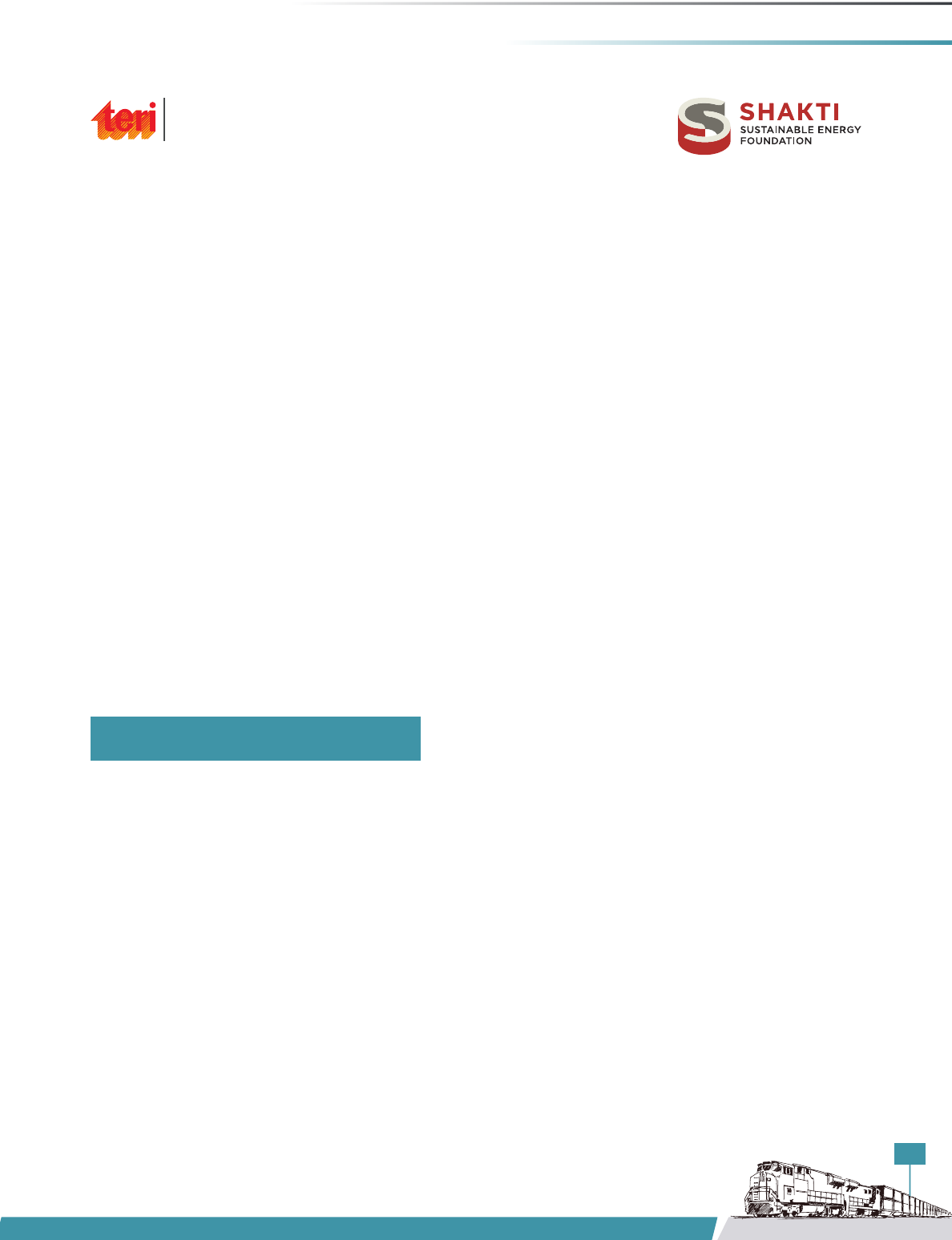
INCREASING RAIL SHARE IN FREIGHT TRANSPORT IN INDIA
MOVING TOWARDS A LOW-CARBON
TRANSPORT FUTURE
Working Paper – Fly Ash
THE ENERGY AND
R
ESOURCES INSTITUTE
Creating Innovative Solutions for a Sustainable Future
Increasing Rail Share in
Freight Transport in India
3

4
WORKING REPORT – FLY ASH
© The Energy and Resources Institute 2019
T E R I. 2019
Increasing Rail Share in Freight Transport in India : Working Paper – Fly Ash
New Delhi: The Energy and Resources Institute.
Project Report No. 2016UD05
About Shakti: Shakti Sustainable Energy Foundation works to strengthen the energy security of India by aiding the
design and implementation of policies that support energy efficiency, renewable energy and sustainable mobility.
Disclaimer: The views/analysis expressed in this report/document do not necessarily reflect the views of Shakti
Sustainable Energy Foundation. The Foundation also does not guarantee the accuracy of any data included in this
publication nor does it accept any responsibility for the consequences of its use.
For more information
Project Monitoring Cell
T E R I Tel. 2468 2100 or 2468 2111
IHC Complex, Lodhi Road Fax 2468 2144 or 2468 2145
New Delhi – 110 003 Web www.teriin.org
India India+91•Delhi(0)11
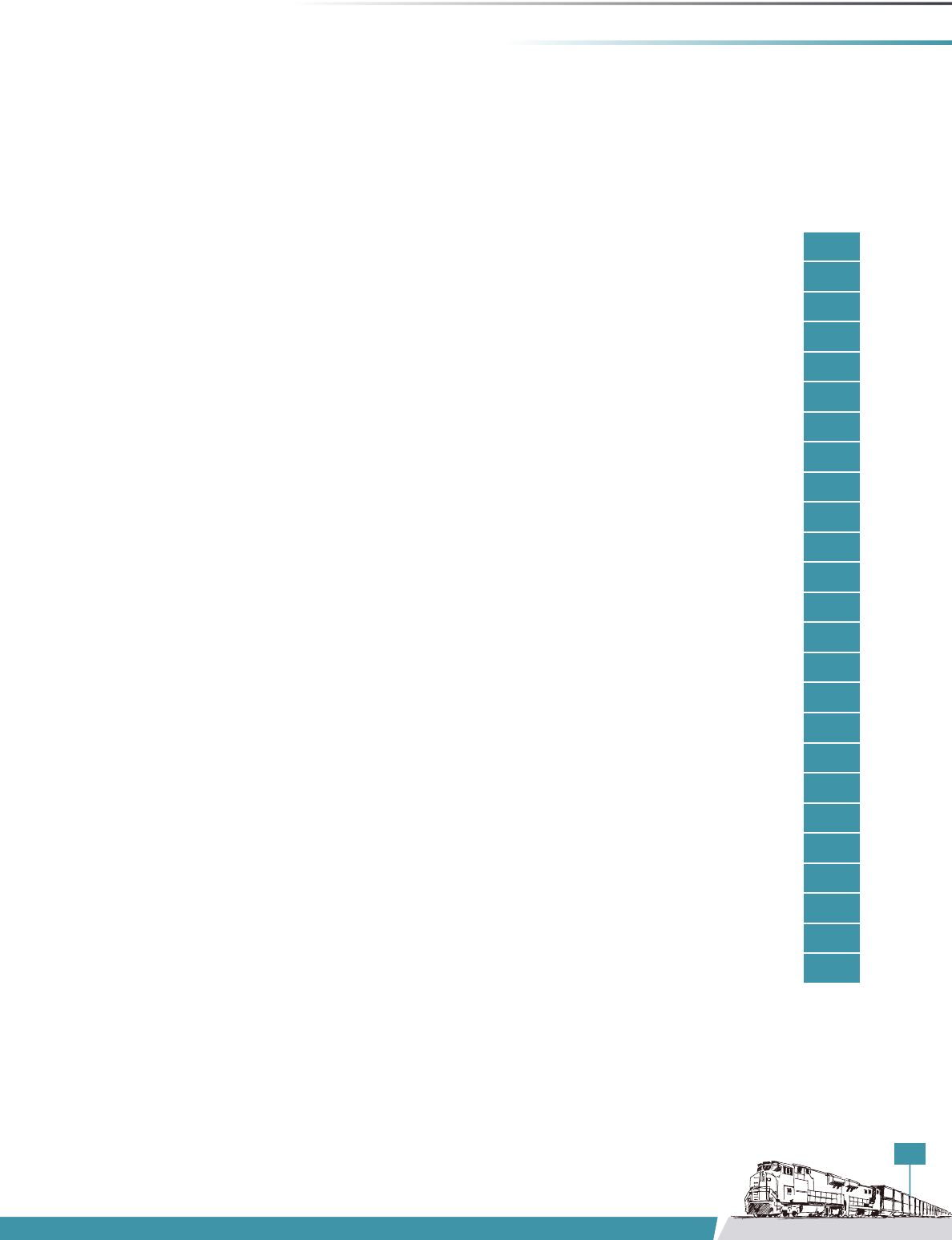
5
INCREASING RAIL SHARE IN FREIGHT TRANSPORT IN INDIA
TABLE OF CONTENTS
Working Paper – Fly Ash 9
Background 9
Aim of the Study 9
Objectives 9
Policies for Fly Ash Transport in India 9
CPCB Guidelines for Transportation of Fly Ash in India 9
MoEF&CC Guidelines towards Utilization of Fly Ash in India 10
Fly Ash Transportation 11
Fly Ash Generation & Utilization 12
Scenario of Fly Ash Production in India 12
State wise Scenario of Fly Ash Production in India 14
Plant wise Scenario of Fly Ash Production in India 16
Mode of Utilization of Fly Ash 19
Scenario of Fly Ash Transport in Indian Railways 20
OriginDestination(O-D)Analysis 21
Rake Composition 22
Fly Ash Transport in Cement Industry 24
Opportunity of fly ash transport by Rail 28
Estimation of Costs and Benefits involved in Transporting Fly Ash 34
Issues 41
Issues with Indian Railways 41
Issues with NTPC 41
Issues with Cement Plants 42
Recommendations 42
Bibliography 43

6
WORKING REPORT – FLY ASH
LIST OF FIGURES
Figure 1: Process showing Handling and Storage of Fly Ash 11
Figure 2: Photograph showing Fly Ash Loading Silos and Road Bulkers 12
Figure 3: Scenario of Fly Ash Generation in India 13
Figure 4: Scenario of Fly Ash Utilization in India 13
Figure 5: An Overall Scenario of Fly Ash Production in India 13
Figure6: StatewiseScenarioofFlyAshProductioninIndia(2016-17) 15
Figure7: LocationofCoal/LignitebasedThermalPowerStationsinIndia 17
Figure8: Top20TPSinIndiaalongwithProductionFigures(2016-17) 19
Figure 9: Major Modes of Fly Ash Utilization 20
Figure 10: Fly Ash Tonnage Carried by Railways 20
Figure 11: Fly Ash Movement Trends in Indian Railways 21
Figure 12: Major Origin and Destination Nodes for Transporting Fly Ash through Railways 23
Figure 13: Various type of Wagons used in transporting fly ash via Rail 24
Figure 14: Covered Car “BCCW’’ wagon for bulk transport of Cement/Fly Ash 24
Figure 15: BCCW wagons for bulk transport of Cement/Fly Ash 24
Figure 16: BTAP Wagon 24
Figure17: ShareofPPCcementandOPCcementintotalcementproduction 25
Figure18: SpatialdistributionofCementplantsinIndiaalongwiththeThermalPowerPlants(BufferRange–100km) 26
Figure19: SpatialdistributionofCementplantsinIndiaalongwiththeThermalPowerPlants(BufferRange–300km) 27
Figure 20: Pneumatic Unloading Facility for Bulker Trucks at Prism Cement, Satna 29
Figure 21: Mechanized fly ash unloading through Truck Tippler at Prism Cement, Satna 29
Figure 22: Map showing location of Cement Plants in Rewa-Satna region & Thermal Power Plants in Singrauli region 30
Figure 23: Map showing rail connectivity of transporting fly ash from Raghavpuram siding to Vasavadatta
Cement Ltd, Sedam 31
Figure 24: Railway Wagons before and after modification 32
Figure 25: Fly Ash loading at NTPC, Ramagundam 32
Figure 26: Map showing rail connectivity of transporting fly ash from Raichur Thermal Power Station to Vasavadatta Cement
Ltd, Sedam 33
Figure27: MapshowinglocationofSingrauliRegion 35
Figure 28: Map showing location of Thermal Power Stations in Singrauli Region and Cement Plants in Rewa-Satna Region 36
Figure 29: Annual Rail and Road Cost Comparisons for Cement Plants 38
Figure 30: Comparison of Annual
CO
2
Emissions 40

7
INCREASING RAIL SHARE IN FREIGHT TRANSPORT IN INDIA
LIST OF TABLES
Table 1: Annual Backlog of Fly Ash along with Percent of Utilization 14
Table 2: State wise scenario of fly ash production in India 15
Table3: ListofTop20ThermalPowerStations(TPS)inIndiaintermsofGenerationofFlyAsh 17
Table 4: Mode of Fly ash Utilization 19
Table 5: Scenario of Fly Ash Transport by Indian Railways 21
Table6: Origin-DestinationTableshowingrakemovementofyashbyIndianRailwaysbetween2011and2017
(Numberofrakes) 22
Table7: MajorOriginNodesintermsofFlyAshTransportthroughIndianRailways 22
Table 8: Major Destination Nodes in terms of Fly Ash Transport through Indian Railways 23
Table 9: Share of PPC in Total Cement Production 25
Table 10: Thermal Power Stations in Singrauli Region [6] 29
Table12: CostofmovingyashfromRaichurtoSedambyRail(2007-08) 34
Table 13: List of Cement Plants selected to estimate Annual Fly Ash Demand 35
Table 14: Fly Ash availability in major Thermal Power Stations in Singrauli Region 36
Table15: AnnualestimatedcostsfortransportingyashfromSingrauliregiontoCementPlantsbyRoad 37
Table16: AnnualestimatedcostsfortransportingyashfromSingrauliregiontoCementPlantsbyRail 37
Table17: ComparisonofRoadandRailcostsaswellasrespectiveSavings 38
Table 18: Assumptions taken for calculating savings in
CO
2
emissions 39
Table 19 : Savings in
CO
2
Emissions 40


INCREASING RAIL SHARE IN FREIGHT TRANSPORT IN INDIA
9
ACKNOWLEDGMENT
TheEnergyandResourcesInstitute(TERI)wouldliketoexpressdeepgratitudetotheMemberTrafcandRailway
Boarddirectorates(Trafc,Commercial,FreightMarketing,andCoaching)fortheirsupportandguidancethroughout
the study. TERI also thanks the officers at different zonal railways in sharing valuable inputs for the study. This report
wouldnothavebeenpossiblewithoutthesupportandguidanceoftheIndianRailways(IR).
TERI extends sincere thanks to various stakeholders and industry representatives from power sector (NTPC) and
cementsector(ACCCementandUltraTechCement)whosharedtheirinsightsandideastowardsincreasingtheshare
of IR’s freight loading.
We also extend sincere gratitude to Shakti Sustainable Energy Foundation in supporting TERI to undertake this study.
The project team also acknowledges the contribution of Mr Shri Prakash, Distinguished Fellow, TERI, and Mr Deepak
Nath, Independent Consultant and Ex-Railway Personnel towards reviewing and enriching the study with their
valuable suggestions and experience of the railways sector. We take this opportunity to thank the editorial and design
team at TERI for their contribution.
Project Team
Team Lead
Mr Shri Prakash
Project Investigator
Mr Sharif Qamar
Advisor
Mr Deepak Nath
Team
Mr Narendra Verma
Mr Sharif Qamar
Secretarial Assistance
Ms Sonia Khanduri


11
INCREASING RAIL SHARE IN FREIGHT TRANSPORT IN INDIA
FLY ASH
With a share of over 60% in total electricity generation,
the volume of fly ash generated by the thermal power
plants in India is significantly high. Fly ash, which is a
by-product of coal-based power generation, is a fine
hazardous powder. It is produced by the combustion
of powdered coal and collected in electrostatic
precipitators(ESPs).
Over the past decade, the generation of fly ash by the
Indian thermal power plants has increased significantly.
Indian coal, which is used in power plants, has a low
caloric value and high ash content (30–45%), which
generates huge quantities of fly ash. Country’s track
record of utilizing fly ash has also been poor. Fly ash finds
several applications in areas such as agriculture, cement
manufacturing, brick industry, construction of road and
rail embankments, reclamation of low-lying areas, mine
fillings, etc. The pozzolanic property of fly ash/lime
reactivity makes it suitable for use in manufacturing of
cement and concrete.
Any thermal power station, generally, has four kinds of fly
ash, which are:
Hopper ash: This kind of ash comes out of the boiler
along with flue gases. It is collected by ESPs in a dry form.
This dry fly ash is collected from different ESP fields and
is of varying fineness. The fly ash collected from the ESP
fields nearer to the boiler is coarser than that collected
fromtheESPeldsawayfromtheboiler(thatis,nearer
tothechimney).
Bottom ash: This kind of ash gets collected at the bottom
of the boiler furnace and is, thus, referred to as bottom
ash. It is coarser than dry fly ash/hopper ash.
Pond ash: When dry fly ash and bottom ash, or both
mixed together, is carried in the form of water slurry and
deposited in ponds where water gets drained away, the
deposited ash is termed as pond ash.
Mound ash: When fly ash and bottom ash, or both mixed
in any proportion, gets deposited in a dry form in the
shape of a mound, it is termed as mound ash.
Aim of the Study
The study aims to examine the existing scenario of fly-
ash transport in India, with a specific emphasis on the
movement of fly ash through the Indian railways, as well
as to come up with strategies to increase the share of
railways in transporting fly ash.
Objectives
In order to fulfil the aim of the study, the following
objectives have been formulated:
¾ To understand the existing scenario of fly-ash
generation and utilization in India
¾ To understand the existing transportation scenario of
fly ash in railways
¾ To identify the potential supply-and-demand clusters
of fly ash
¾ To identify the factors responsible for the low modal
share of fly ash in railways
¾ To develop fly-ash-specific strategies to increase the
modal share of railways in transportation of fly ash
While the study team aimed at following above, lack of
data and information regarding transport demand flows
related to fly ash were areas of limitations in certain
instances.
Guidelines and Policies for
Fly-Ash Transportation in India
There are a two major guidelines issued by government
agencies, which have been listed in this section. These
guidelines are issued by the Central Pollution Control
Board (CPCB) andthe Ministry of Environment, Forests
andClimateChange(MoEF&CC).Itistobenotedatthe
outset that since these are guidelines, the parties involved

12
WORKING REPORT – FLY ASH
in the generation, transportation, and utilization aspects
of fly ash are not bound to adhere/follow. Interactions
with the stakeholders indicate that specialized wagons
or trucks are not deployed to transport fly ash from
production point to consumption point.
CPCB Guidelines for Fly-Ash
Transportation
The CPCB has framed guidelines for loading, unloading,
utilization, and nuisance-free transportation of all types
of fly ash, including dry fly ash and bottom ash generated
bythermalpowerstations(TPS).Consideringthevarious
aspects of handling and transportation of fly ash, the
CPCB suggests the following modes of transportation for
different end users of fly ash so as to avoid dust emission
(CPCB,2013).
Cement/Asbestos Manufacturing
¾ Only specially designed road tankers/bulkers or
mechanically designed, covered trucks provided with
automatic loading and unloading system should be
used.
¾ Specially designed railway wagons should be used
for transport by rail.
Manufacturing of Fly-Ash-based Brick, Tiles and
Blocks
¾ Tankers/ bulkers or mechanically designed, covered
trucks shall be used.
¾ In case of tractors, trolleys which have the provision
of a box-type cover on top with a hydraulic unloading
system should be deployed for transporting dry or
wet fly ash.
Mine/Abandoned Quarry Backfilling
¾ Tankers/bulkers or mechanically designed, covered
trucks shall be used.
¾ Based on topography considerations and feasibility
of the system, pipe conveyors can also be used.
¾ Ash slurry pipeline systems can be used to transport
ash slurry directly from thermal power plants to
abandoned mines, if permitted.
Road Construction and Filling of Low-Lying Area
¾ Tankers/bulkers or mechanically designed, covered
trucks shall be used.
MoEF&CC Guidelines for Fly-Ash
Utilization
To address the issue of fly-ash disposal in ash ponds and
to reduce the problem of pollution caused by fly ash,
the MoEF&CC has issued various notifications on fly-
ash utilization. The first notification was issued on 14th
September, 1999, which was subsequently amended
in 2003, 2009, and 2016 vide notications dated 27th
August 2003, 3rd November 2009, and 25th January
2016, respectively.
To enhance the efforts for gainful utilization of fly ash,
the latest MoEF&CC’s notification of 25th January 2016
mandates(MoEF&CC,2016):
¾ Every agency engaged in construction within
a 300-km range of any coal- or lignite- based
thermal power plant must use only fly-ash-based
materials for construction. This shall be applicable
to all construction agencies whether government or
private.
¾ No agency, person, or organization is allowed to
construct or approve the design of road or flyover
embankments with top soil within a 300-km range of
any coal- or lignite- based thermal power plant. Also,
the fly ash used for such embankment construction
shall strictly adhere to the guidelines specified in IRC
SP:58 of 2001, as amended from time to time.
¾ No agency, person, or organization shall undertake
or approve or allow reclamation and compaction of
low-lying areas with soil within a 300-km radius of
any coal- or lignite-based thermal power plant. Only
fly ash shall be used for compaction and reclamation.
¾ The cost of transportation of fly ash for road-
construction projects, or manufacturing of ash-based
projects, or any agricultural activity where ash is
being used as soil conditioner within a 100-km radius
of any coal-based thermal power plant has to be
borne entirely by TPS and equally divided between
the user and the thermal power station for distances
more than 100 km and up to 300 km. In case of road-
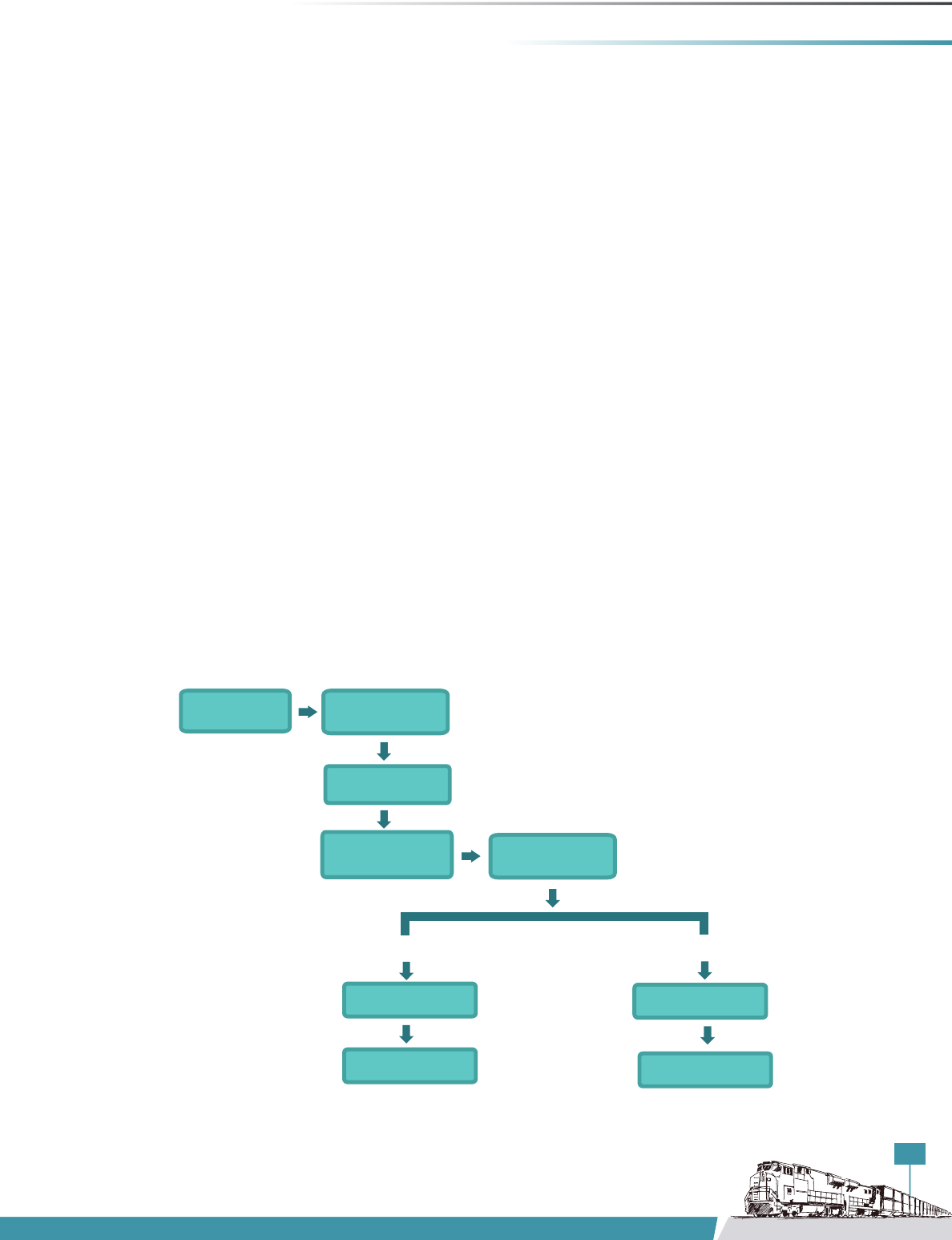
13
INCREASING RAIL SHARE IN FREIGHT TRANSPORT IN INDIA
construction projects under the Pradhan Mantri Gram
Sadak Yojana and asset-creation programmes of the
government, involving construction of buildings,
roads, dams, and embankments, power plants shall
bear the entire cost of ash transportation to the site
within a 300-km radius.
¾ Pond ash should be made available free of cost
on an ‘as is where is’ basis to the manufacturers of
bricks, tiles, or blocks, including manufacturing units
that make clay based fly ash products; farmers, the
central and state road-construction agencies, the
Public Works Department, and agencies engaged in
backfilling or stowing of mines.
¾ It is also mandatory to use fly-ash-based products in
all government schemes or programmes, for example,
Pradhan Mantri Gram Sadak Yojana, Mahatma Gandhi
National Rural Employment Guarantee Scheme, and
Swachh Bharat Abhiyan.
¾ No person or agency shall undertake or approve
stowing of mines without using at least 25% of fly
ash on weight-to-weight basis of the total stowing
materials used within a 50-km radius of a coal- or
lignite-based thermal power plant.
Fly-Ash Transportation
Fly-ash transportation has many challenges as fly-ash
particles are lightweight and can potentially get airborne
easily and pollute the environment. Furthermore, its
airborne character requires it to be transported in
an enclosed container. As fly ash is used for a variety
of purposes discussed earlier, proper and adequate
measures should be undertaken while handling and
transporting it.
Handling and Disposal of Fly Ash within
the Power Plant
Fly ash collected from ESPs can be disposed of either in
dry form or wet-slurry form. Dry ash is typically conveyed
pneumatically from ESPs to storage silos, where it is kept
dry till further processing, while bottom ash, which is
collected from the bottom of the boiler, is disposed of
into ash ponds in the form of wet slurry.
The following technologies are conventionally used for
handling and disposal of fly ash and bottom ash from
ESPswithintheplantoruptotheash-pondarea(CPCB,
2013):
Fly Ash Silo
Ash Pond
Ulisaon
Ulisaon
Boiler
Electrostac
Precipitator
Coal/Lignite
Coal Pulveriser
Transfer
System
(Dry) (Wet)
Figure 1: Process showing Handling and Storage of Fly Ash
Source: CPCB Guidelines for Transporting Fly ash, 2013
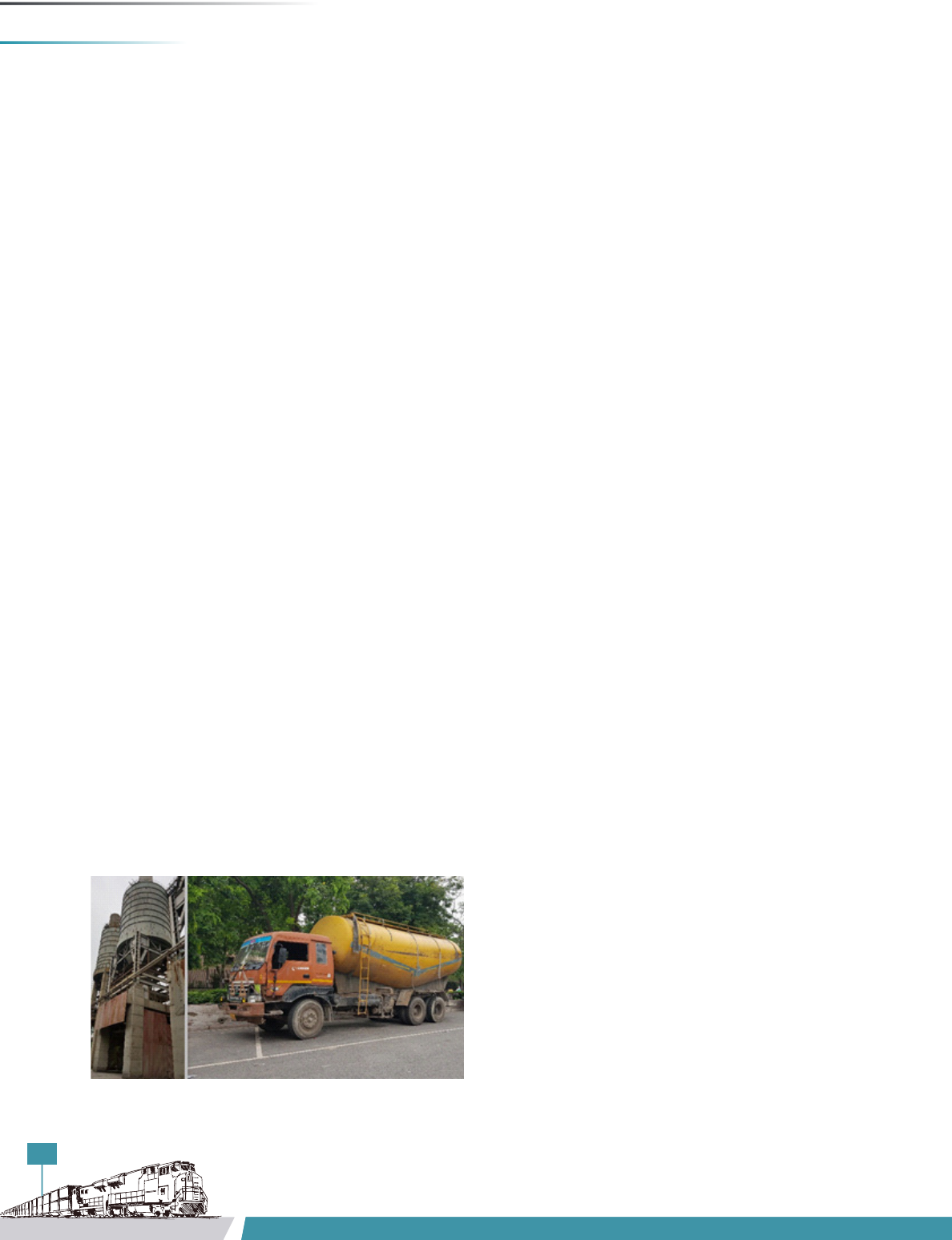
14
WORKING REPORT – FLY ASH
¾ Pneumatic conveying
¾ Lean slurry disposal system
¾ Medium concentration slurry disposal system
¾ High concentration slurry disposal system
¾ Dry(moist)conveyingsystemthroughbeltconveyor/
tube-belt conveyor
Handling and Disposal of Fly Ash
outside the Power Plant
Fly ash is generally transported either from fly-ash silo
or ash pond. The modes of fly-ash transportation are
discussed ahead.
¾ Fly ash is generally transported by tractor trollies or
trucks by brick manufacturers, cement manufacturers,
and construction agencies based upon the
requirementanddistance(CPCB,2013).
¾ Thermal power plants generally construct silos for
intermediate storage of dry fly ash. After fly ash is
loaded into these silos, it is transported to cement
plants either by bulkers or trucks covered with
tarpaulins(seeFigure2).
¾ Fly ash is also transported to abandoned mines by
trucks covered suitably with tarpaulins. However, due
to the non-availability of abandoned mines, mine
backfilling using fly ash is carried out in very few
thermalpowerplants(CPCB,2013).Asperthe2009
notification, fly-ash disposal in abandoned mines or
quarries should be carried out under the guidance of
theDirectorateGeneralofMine Safety (DGMS) and
the power plant authorities shall regularly monitor
the groundwater in the surrounding area to assess
groundwater contamination.
Figure 2:Photograph showing Fly Ash Loading Silos and Road Bulkers
Source: TERI
Fly-Ash Generation and
Utilization in India
Indian coal is low-grade with an ash content of 30–45%,
in comparison to imported coal which has low ash
content, that is, 10–15%. (CEA, 2016-17) This results in
the generation of large quantities of ash by coal-/lignite-
based TPS in the country.
Fly-Ash Production
The Central Electricity Authority (CEA) has been
monitoring the status of fly-ash generation and its
utilization in the country since 1996. As per the CEA
report,(CEA,2016-17)datacollatedfrom155TPSacross
the country has been presented here to arrive at the
present status of fly-ash generation and utilization in
India.
Fly-ash generation has increased from 68.9 million
tonnes in 1996–97 to 169.3 million tonnes in 2016–17
(CEA, 2016-17). Figure 3 shows the progressing y-ash
generationfrom1996–97to2016–17.
Similarly, the utilization of fly ash has increased from
6.6milliontonnesin1996–97to107.1milliontonnesin
2016–17(CEA,2016-17).Figure4showstheprogressing
y-ashutilizationfrom1996–97to2016–17.
A large number of technologies have been developed
for the gainful utilization and safe management of fly
ash. As a result, both the generation and utilization of fly
ash have increased significantly over the past decade.
Figure 5 represents the total annual production of fly
ash along with its corresponding utilization figures. The
percentage of fly-ash utilization has increased from 9.6%
in1996–97to63.3%in2016–17.
Although it appears from the Figure 5 that the utilization
of fly ash has increased significantly in recent years, it
does not entirely reflect the reality of the situation. It is
important to note that the annual backlog tonnage of
fly ash has been neglected in this analysis to arrive at the
exact utilization level; hence, it is necessary to include
the same to arrive at more realistic figures, and if we were
to do so, the utilization level will go down significantly.
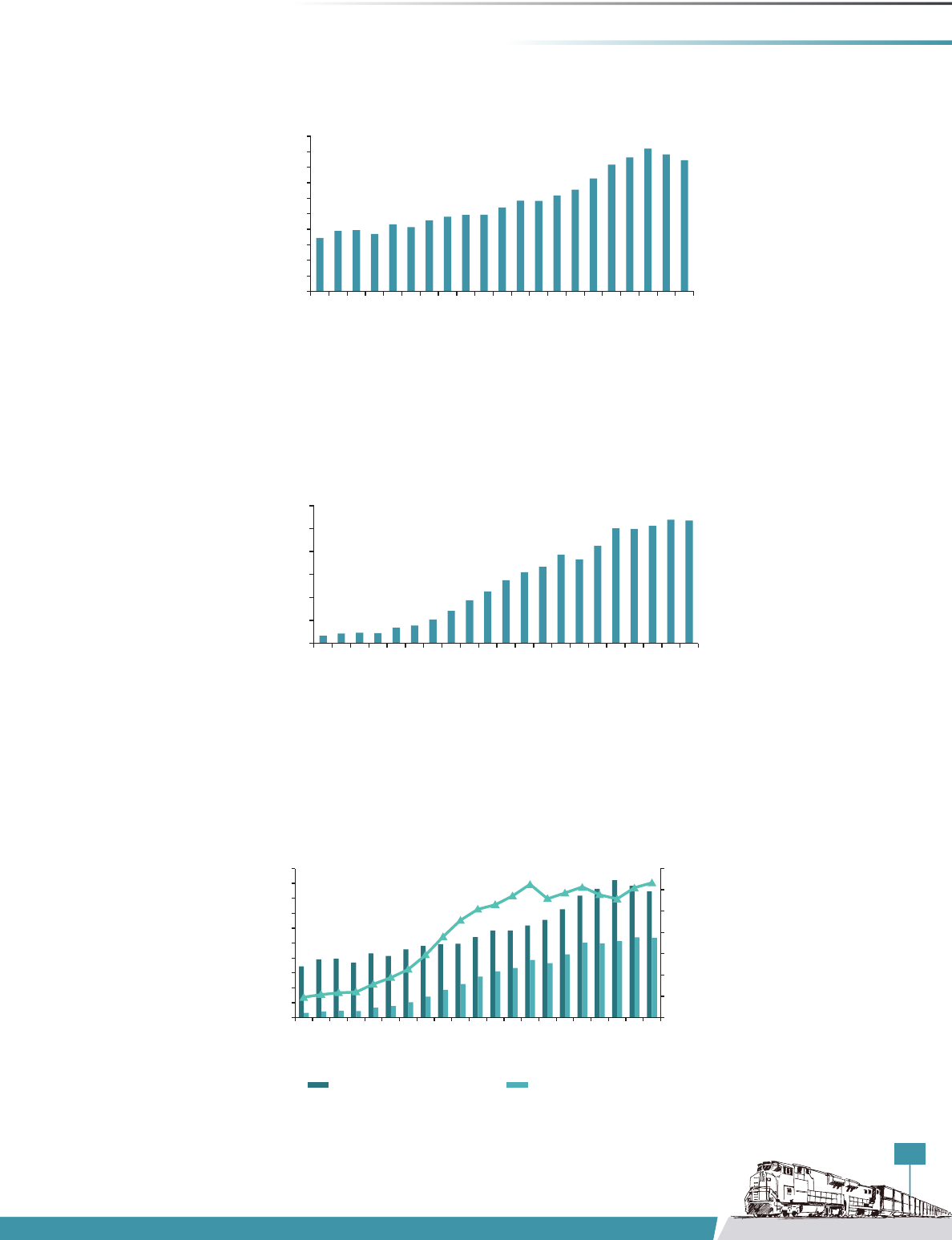
15
INCREASING RAIL SHARE IN FREIGHT TRANSPORT IN INDIA
Figure 5: An Overall Scenario of Fly Ash Production in India
Source: Report on Fly Ash Generation, Central Electricity Authority (2016-17)
0
10
20
30
40
50
60
70
0
20
40
60
80
100
120
140
160
180
200
1996-97
1997-98
1998-99
1999-2000
2000-01
2001-02
2002-03
2003-04
2004-05
2005-06
2006-07
2007-08
2008-09
2009-10
2010-11
2011-12
2012-13
2013-14
2014-15
2015-16
2016-17
Fly Ash Ulizaon (%)
Million Tonnes
Year
Fly Ash Scenario in India: Producon vs Ulizaon
Fly Ash Producon (million-tonne) Fly Ash Ulizaon (million-tonne)
68.9
78.1
79.0
74.0
86.3
82.8
91.7
96.3
98.6
99.0
108.2
116.9
116.7
123.5
131.1
145.4
163.6
172.9
184.1
176.7
169.3
0.0
20.0
40.0
60.0
80.0
100.0
120.0
140.0
160.0
180.0
200.0
1996-97
1997-98
1998-99
1999-2000
2000-01
2001-02
2002-03
2003-04
2004-05
2005-06
2006-07
2007-08
2008-09
2009-10
2010-11
2011-12
2012-13
2013-14
2014-15
2015-16
2016-17
Million Tonnes
Year
Fly Ash Generaon (million-tonne)
Figure 3: Scenario of Fly Ash Generation in India
Source: Report on Fly Ash Generation, Central Electricity Authority (2016-17)
6.6
8.4
9.2
8.9
13.5
15.6
20.8
28.3
37.5
45.2
55.0
62.0
66.6
77.3
73.1
85.1
100.4
99.6
102.5
107.8
107.1
0.0
20.0
40.0
60.0
80.0
100.0
120.0
1996-97
1997-98
1998-99
1999-2000
2000-01
2001-02
2002-03
2003-04
2004-05
2005-06
2006-07
2007-08
2008-09
2009-10
2010-11
2011-12
2012-13
2013-14
2014-15
2015-16
2016-17
Million Tonnes
Year
Fly Ash Ulizaon (million-tonne)
Figure 4: Scenario of Fly Ash Utilization in India
Source: Report on Fly Ash Generation, Central Electricity Authority (2016-17)

16
WORKING REPORT – FLY ASH
Table 1: Annual Backlog of Fly Ash along with Percent of Utilization
S. No. Year Fly Ash
Production
(Million-
Tonnes)
Fly Ash
Utilization
(Million-
Tonnes)
Fly Ash
Utilization
Cumulative
Backlog of
Fly Ash
( Million
Tonnes)
Fly Ash
Utilization
in % (After
Including
Backlog
Tonnage)
1 1996-97 68.9 6.6 9.6% 62.2 -
2 1997-98 78.1 8.4 10.8% 131.9 6%
3 1998-99 79.0 9.2 11.7% 201.6 5%
4 1999-2000 74.0 8.9 12.0% 266.8 3%
5 2000-01 86.3 13.5 15.7% 339.5 4%
6 2001-02 82.8 15.6 18.8% 406.8 4%
7 2002-03 91.7 20.8 22.7% 477.6 4%
8 2003-04 96.3 28.3 29.4% 545.6 5%
9 2004-05 98.6 37.5 38.0% 606.7 6%
10 2005-06 99.0 45.2 45.7% 660.4 7%
11 2006-07 108.2 55.0 50.9% 713.6 8%
12 2007-08 116.9 62.0 53.0% 768.5 8%
13 2008-09 116.7 66.6 57.1% 818.6 8%
14 2009-10 123.5 77.3 62.6% 864.8 9%
15 2010-11 131.1 73.1 55.8% 922.8 8%
16 2011-12 145.4 85.1 58.5% 983.1 9%
17 2012-13 163.6 100.4 61.4% 1,046.3 10%
18 2013-14 172.9 99.6 57.6% 1,119.6 9%
19 2014-15 184.1 102.5 55.7% 1,201.2 9%
20 2015-16 176.7 107.8 61.0% 1,270.1 8%
21 2016-17 169.3 107.1 63.3% 1,332.3 8%
Source: Report on Fly Ash Generation, Central Electricity Authority (2016-17)
Table 1 represents the details of fly-ash backlog along
with the utilization percentage. Lower utilization of
fly ash over the years has led to the piling up of huge
stocks of fly ash. The table makes it evident that a total
of 1,332 million tonnes of fly ash has been stocked on
groundasof2016–17,ofwhichonly107milliontonnes
were utilized, that is, only 8% of the total fly ash available
on ground. The table also highlights the significant
difference between percentages of utilization before
and after, including the backlog stocks of fly ash. It is to
be noted that the utility of fly ash diminishes with time
due to contamination.
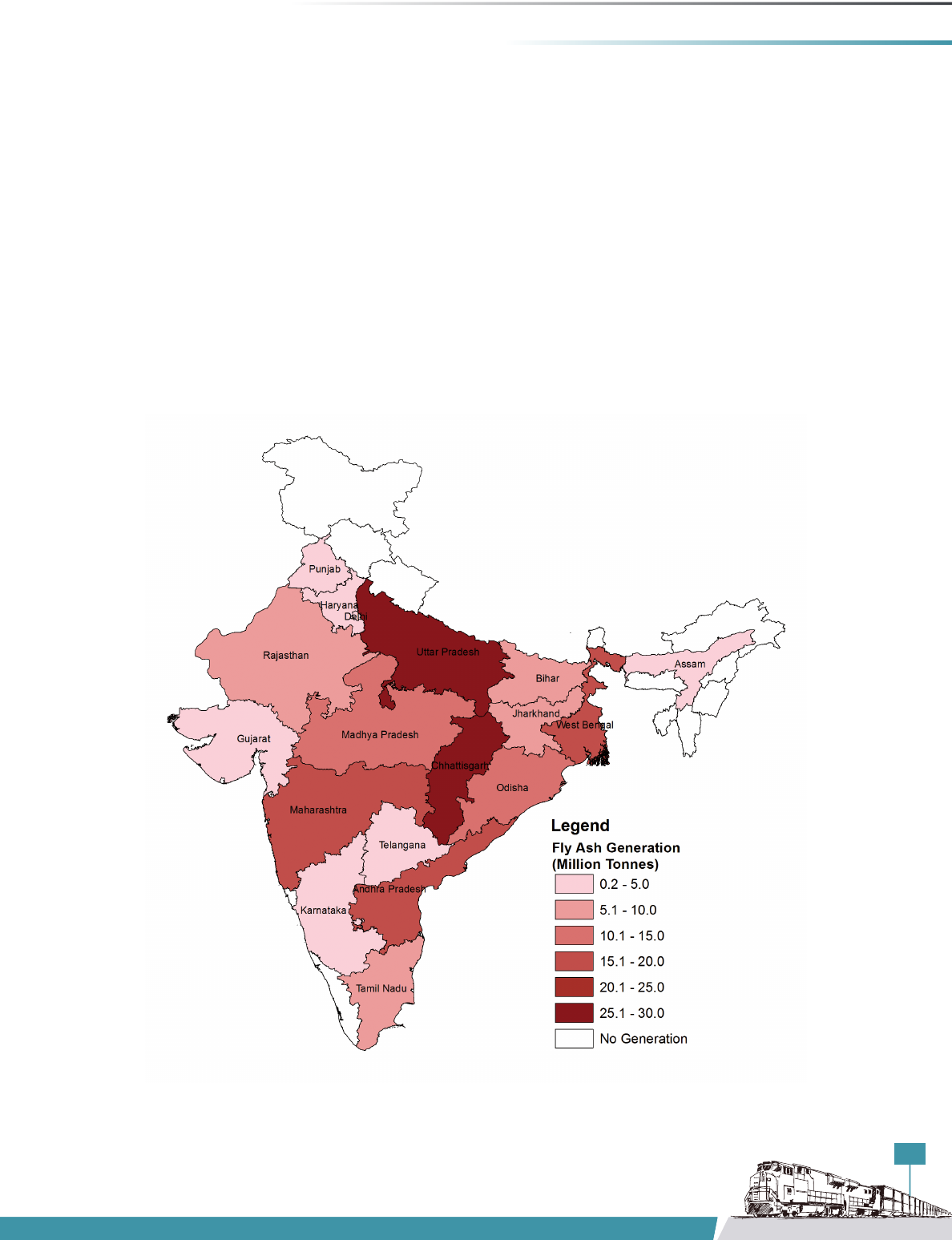
17
INCREASING RAIL SHARE IN FREIGHT TRANSPORT IN INDIA
Figure 6:StatewiseScenarioofFlyAshProductioninIndia(2016-17)
Source: Report on Fly Ash Generation, Central Electricity Authority (2016-17)
State-Wise Scenario of Fly-Ash
Production
State-wise generation trends for 2016–17 suggest
that Andhra Pradesh, Chhattisgarh, Madhya Pradesh,
Maharashtra, Uttar Pradesh, and West Bengal are the
most significant states contributing to more than 50%
of the total fly-ash generation in the country. Figure 6
shows the state-wise production of fly ash in the country.
It is evident from the map that Uttar Pradesh and
Chhattisgarh produce the maximum fly ash, whereas
Punjab, Haryana, Karnataka, and Telangana are the states
with least production.
The reason these states have higher production is
the number of power plants installed within their
boundaries. These states have the highest number of
thermalpowerplantsinstalledinthecountry(seeTable
2).AlthoughGujaratisanexception,asdespitethetotal
installed capacity of 15,472 MW, it has generated only
3.5 million tonnes of fly ash. Most of these power plants
useimportedcoalwithashcontentaslowas6–7%, as
compared to Indian coal with ash content of 30–45%.
Hence, the amount of ash produced is also comparatively
less. Table 2 shows the generation and utilization figures
of all the states.

18
WORKING REPORT – FLY ASH
Table 2 : State wise scenario of fly ash production in India
S.No. State No. of
Thermal
Power
Stations
Installed
Capacity
(MW)
Fly Ash
Generation
(Million-
Tonnes)
Fly Ash
Utilization
(Million-
Tonnes)
Fly Ash
Utilization
in %
1 Uttar Pradesh 18 19,104 28.3 13.2 47%
2 Chhattisgarh 20 17,740 25.2 10.8 43%
3 Andhra Pradesh 10 10,973 17.8 12.7 71%
4 West Bengal 17 14,142 16.7 13.8 83%
5 Maharashtra 20 21,556 16.5 11.8 71%
6 Odisha 5 5,188 11.5 6.4 56%
7 Madhya Pradesh 7 10,640 11.4 4.1 36%
8 Bihar 4 4,100 7.4 2.4 32%
9 Rajasthan 8 7,840 6.8 6.4 95%
10 Jharkhand 7 5,613 6.7 7.3 108%
11 Tamil Nadu 10 8,430 6.2 4.6 75%
12 Haryana 5 5,550 4.1 5.3 128%
13 Gujarat 11 15,472 3.5 3.5 102%
14 Karnataka 4 5,480 3.1 1.7 56%
15 Telangana 3 1,820 2.7 1.0 36%
16 Punjab 3 2,640 0.9 1.4 162%
17 Delhi 2 840 0.4 0.6 157%
18 Assam 1 250 0.2 0.0 0%
Grand Total 155 1,57,377 169.3 107.1 63%
Source: Report on Fly Ash Generation, Central Electricity Authority (2016-17)
As evident from Table 2, states generating more fly
ash do not necessarily have a higher percentage of
utilization when compared to other states. States like
Jharkhand, Haryana, Gujarat, Punjab, and Delhi are
utilizing more than what they are generating, hence
acting as consumption centres of fly ash. On the contrary,
the utilization figures of states like Bihar, Chhattisgarh,
Madhya Pradesh, and Telangana hover around 30–40%,
which is the lowest amongst all the states.
Plant-Wise Scenario of Fly-Ash
Production
Most of the fly-ash generation can be attributed to TPS
located in the states of Uttar Pradesh, Madhya Pradesh,
Chhattisgarh, West Bengal, and Andhra Pradesh. Figure
7showsthelocationofthesepowerplants.Itisevident
from the map that most of the fly-ash production
clusters are located in the middle-eastern part of the
country. The size of the circles in the map represents the
corresponding generation values of each power plant in
million tonnes.
Table 3 lists the top 20 power plants in the country in terms
of fly-ash generation. NTPC Vindhyachal tops the list with
anannualproductionof7.6million tonnesin2016–17
followed by Anpara, NTPC Talcher in Odisha, and NTPC
Sipat and Korba in Chhattisgarh. As mentioned earlier
also, these thermal power stations may not necessarily
be the ones with the highest installed capacity, but since
they use coal with comparatively higher ash content, the
fly-ash generation values are higher irrespective of their
installed capacity.
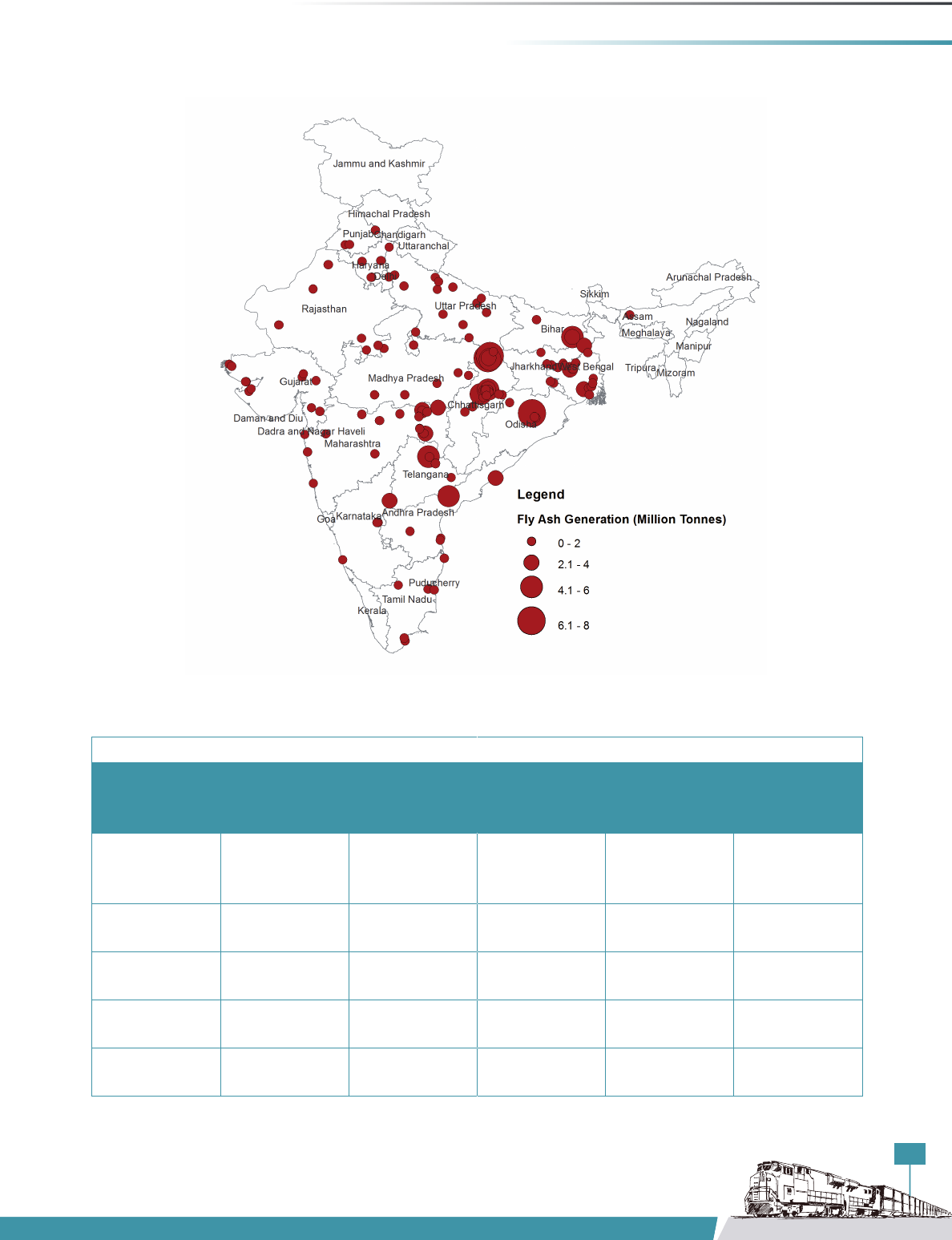
19
INCREASING RAIL SHARE IN FREIGHT TRANSPORT IN INDIA
Figure 7: Location of Coal/Lignite based Thermal Power Stations in India
Source: Report on Fly Ash Generation, Central Electricity Authority (2016-17) & TERI Analysis
Table 3:ListofTop20ThermalPowerStations(TPS)inIndiaintermsofGenerationofFlyAsh
Name of TPS Power Utility &
State
Installed
Capacity (MW)
Fly Ash
Generation
(Million Tonnes)
Fly Ash
Utilization
(Million Tonnes)
Percentage
Utilization (%)
Vindhyachal
(Madhya
Pradesh)
NTPC Ltd.
(Madhya
Pradesh)
4,760 7.6 1.8 23.5%
Anpara
(UttarPradesh)
UPRVYNL
(UttarPradesh)
2,630 7.2 0.0 0.4%
Talcher(Odisha) NTPC Ltd.
(Odisha)
3,000 7.1 3.1 43.2%
Sipat
(Chhattisgarh)
NTPC Ltd.
(Chhattisgarh)
2,980 5.4 1.2 22.8%
Korba
(Chhattisgarh)
NTPC Ltd.
(Chhattisgarh)
2,600 5.1 2.3 45.0%

20
WORKING REPORT – FLY ASH
Table 3:ListofTop20ThermalPowerStations(TPS)inIndiaintermsofGenerationofFlyAsh
Name of TPS Power Utility &
State
Installed
Capacity (MW)
Fly Ash
Generation
(Million Tonnes)
Fly Ash
Utilization
(Million Tonnes)
Percentage
Utilization (%)
Kahalgaon
(Bihar)
NTPCLtd.(Bihar) 2,340 5.1 2.2 44.0%
Rihand
(UttarPradesh)
NTPC Ltd.
(UttarPradesh)
3,000 4.9 0.8 15.5%
Ramagundam
(Andhra
Pradesh)
NTPC Ltd.
(Andhra
Pradesh)
2,600 4.7 4.4 93.1%
Dr. Narla Tata
RaoTPS(Andhra
Pradesh)
APGENCO
(Andhra
Pradesh)
1,760 4.0 3.0 75.4%
Mejia
(WestBengal)
DVC
(WestBengal)
2,340 3.7 4.0 107.0%
Singrauli
(UttarPradesh)
NTPCLtd.(U.P.) 2,000 3.7 0.3 9.1%
Adani Power Ltd.
(Maharashtra)
Adani Power Ltd.
(Maharashtra)
3,300 3.5 2.2 62.2%
Chandrapur
(Maharashtra)
MSPGCL
(Maharashtra)
2,340 3.4 1.6 47.6%
Simhadri
(Andhra
Pradesh)
NTPC Ltd.
(Andhra
Pradesh)
2,000 3.1 206 83.7%
NTPC Farakka
(WestBengal)
NTPC Ltd.
(WestBengal)
2,100 3.0 1.7 55.3%
Korba(West)
(Chhattisgarh)
CSPGCL
(Chhattisgarh)
1,340 3.0 0.1 2.2%
Raichur
(Karnataka)
KPCL(Karnataka) 1,720 2.6 1.4 52.8%
Barh Super TPS
(Bihar)
NTPCLtd.(Bihar) 1,320 2.1 0.1 4.6%
Kolaghat(West
Bengal)
WBPDCL
(WestBengal)
1,260 2.1 2.4 117.6%
Khaparkheda
(Maharashtra)
MSPGCL
(Maharashtra)
1,340 2.0 0.7 36.2%
Source: Report on Fly Ash Generation, Central Electricity Authority (2016-17)
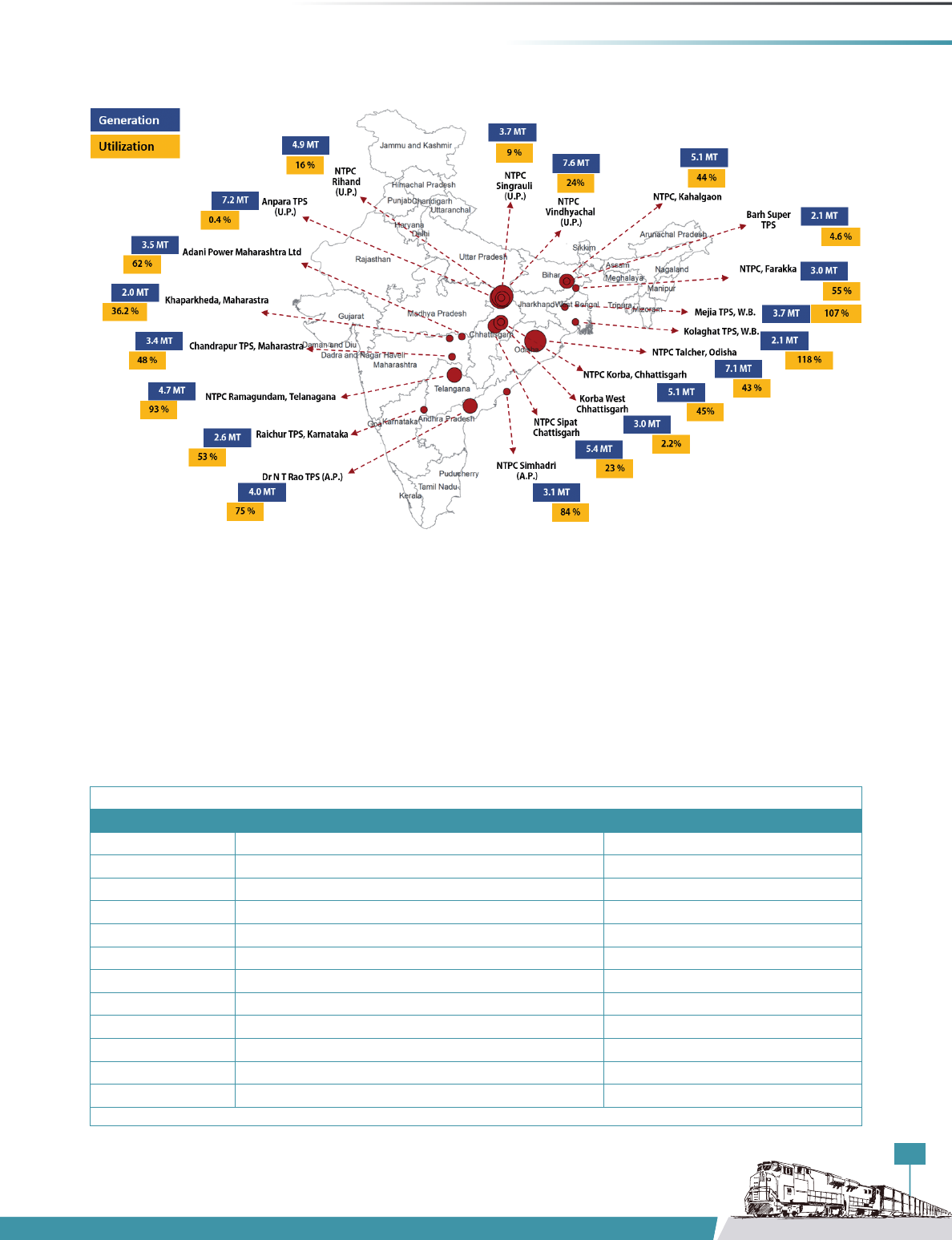
21
INCREASING RAIL SHARE IN FREIGHT TRANSPORT IN INDIA
Figure 8: Top20TPSinIndiaalongwithProductionFigures(2016-17)
Source : Report on Fly Ash Generation , Central Electricity Authority (2016-17) & TERI Analysis
Table 4 : Mode of Fly ash Utilization
S. No. Mode of Utilization Million-Tonnes
1 Cement manufacturing 40.6
2 Mine filling 11.8
3 Bricks & tiles manufacturing 14.9
4 Reclamation of low lying areas 11.0
5 Ash dyke raising 11.9
6 Roads & flyovers 6.2
7 Agriculture 1.9
8 Concrete 0.8
9 Hydro power sector 0.0
10 Others 8.0
11 Unutilized fly ash 62.2
Total 169.3
Source: Report on Fly Ash Generation, Central Electricity Authority (2016-17)
Mode of Fly-Ash Utilization
Fly ash, which was once considered to be ‘hazardous
industrial waste’, has now acquired the status of a
resourceful commodity. The current major modes of fly-
ash utilization in the country as per the CEA are shown
in Table 4.
Table 4 shows that cement manufacturing has the
largest share of fly-ash consumption, followed by brick
manufacturing, reclamation of low-lying areas, and mine
filling. Also, a significant amount of fly ash is still not
utilized. Figure 9 shows the modes of fly ash utilization
during 2016–17. In this report, focus is on the use of
fly ash by cement plants, since bulk movement of the
product is possible by rail with consumption centres
concentrated in select regions.
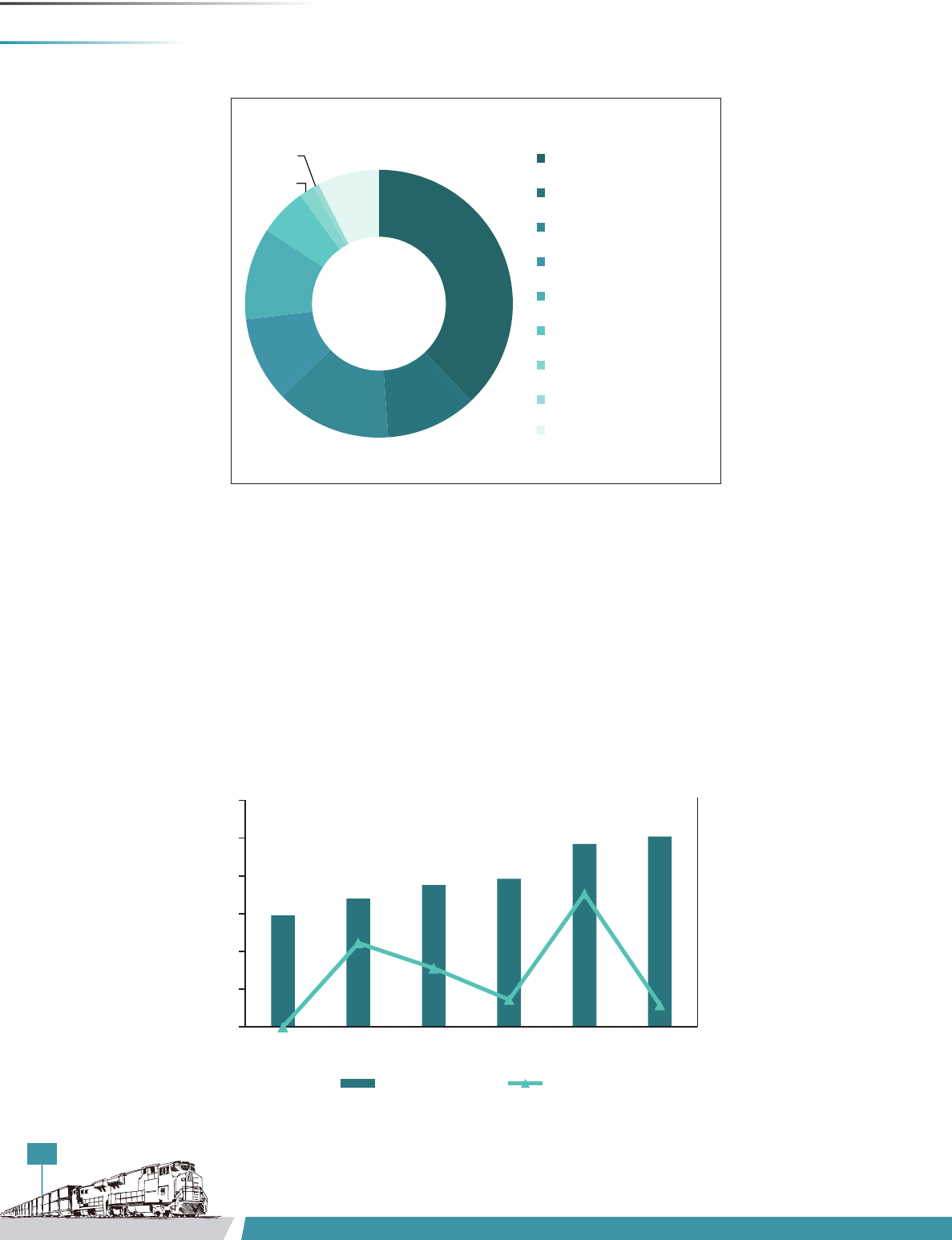
22
WORKING REPORT – FLY ASH
Fly-Ash Transport in Indian
Railways
As per the data received from the Centre for Railway
Information Systems (CRIS), Ministry of Railways, the
tonnage of fly ash carried by railways increased from
1.5 million tonnes in 2011–12 to 2.5 million tonnes in
2016–17.Althoughwhencomparedtothetotalyash
transported, the share of Indian Railways is substantially
low. The modal share of railways in transporting fly ash,
which was 1.7% in 2011–12, has slightly increased to
2.3% in 2016–17. As per CRIS, Indian Railways carried
1.8 million tonnes of y ash during 2017-18. However,
calculations regarding modal share of railways could
not be done as data related to fly ash generation and
utilizationfor2017-18werenotreleasedbytheCEA(at
thetimeofpublishingthisreport).
1.48
1.7
1.88
1.96
2.42
2.52
0
0
0.05
0.1
0.15
0.2
0.25
0.3
0.35
0.4
0
0.5
1
1.5
2
2.5
3
2011-2012 2012-2013 2013-2014 2014-2015 2015-2016 2016-2017
Growth (%)
Tonnage Carried (Million Tonnes)
Fly Ash Carried by Indian Railways
Tonnage Carried Growth(%)
Figure 10: Fly Ash Tonnage Carried by Railways
Source: Centre for Railway Information Systems, Ministry of Railways (2016-17)
38%
11%
14%
10%
11%
6%
2%
1%
7%
Mode of Ulizaon of Fly Ash during Year 2016-17 (%)
Cement
Mine filling
Bricks & Tiles
Reclamaon of low lying
area
Ash Dyke Raising
Roads & flyovers
Agriculture
Concrete
Others
Figure 9: Major Modes of Fly Ash Utilization
Source: Report on Fly Ash Generation, Central Electricity Authority (2016-17)
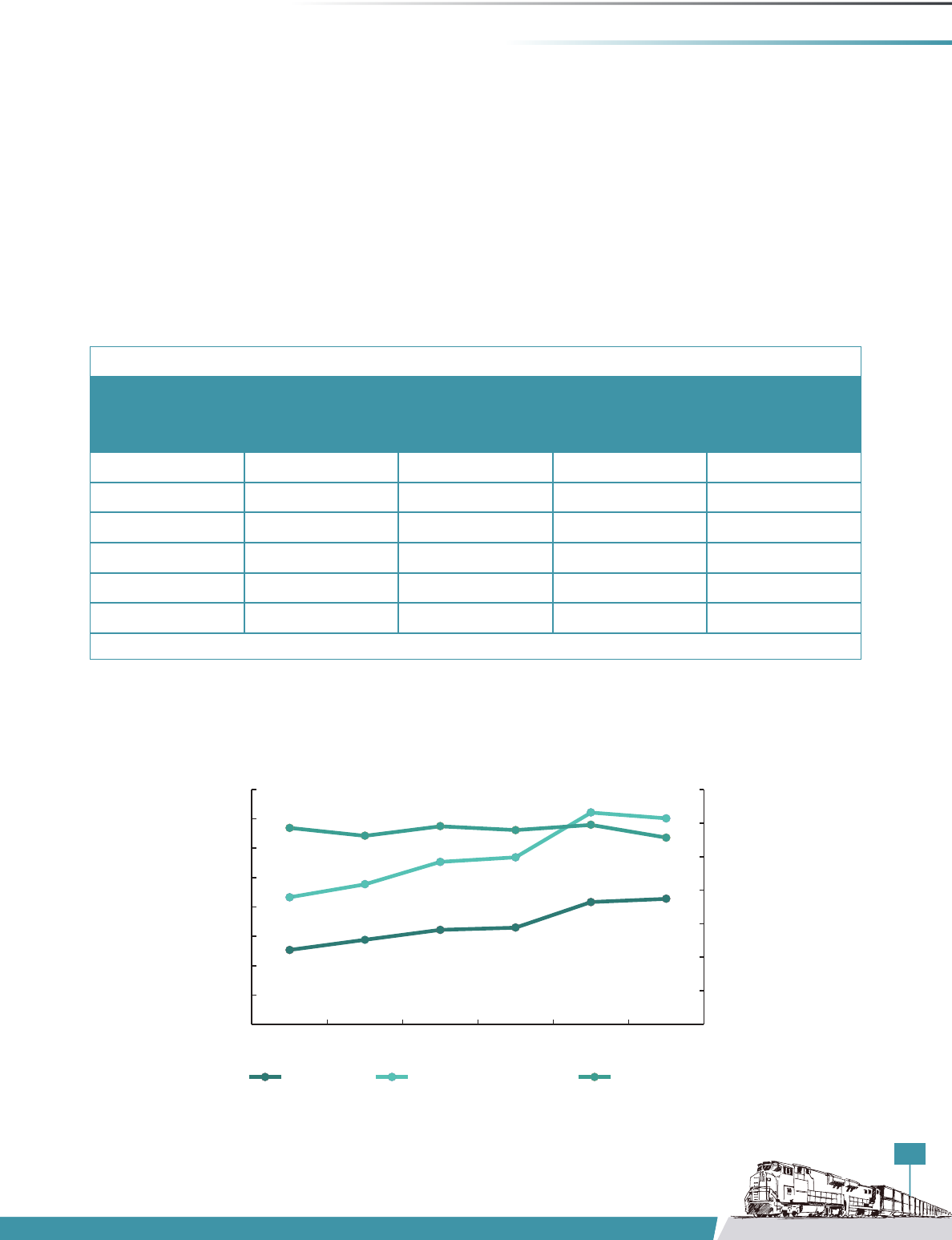
23
INCREASING RAIL SHARE IN FREIGHT TRANSPORT IN INDIA
Table 5: Scenario of Fly Ash Transport by Indian Railways
Year Trips Originating Tonnage Carried
(Million Tonnes)
Net Tonne
Kilometres
(Million)
Average Lead (Km)
2011-2012 507 1.5 866 586
2012-2013 576 1.7 954 562
2013-2014 644 1.9 1107 590
2014-2015 660 2.0 1137 579
2015-2016 833 2.4 1443 595
2016-2017 856 2.5 1403 556
Source: Centre for Railway Information Systems, Ministry of Railways (2016-17)
Figure 11: Fly Ash Movement Trends in Indian Railways
Source: Centre for Railway Information Systems, Ministry of Railways (2016-17)
Figure 10 shows that although the tonnage of fly ash
carried by railways increased significantly, from 2011-12
to2016-17,thegrowthrateforthesamehas notbeen
smooth. There was a substantial spike in growth from 5%
in 2015 to 23% in 2016, but it has again declined to 4%
in2017,whichisthelowestmarkforrailwaysinthepast
six years. Table 5 shows the various parameters related to
fly-ash movement by rail.
0
100
200
300
400
500
600
700
0
200
400
600
800
1000
1200
1400
1600
2011-12 2012-13 2013-14 2014-15 2015-16 2016-17
Average Lead (Km)
NTKM's (Million Tonnes)
Fly Ash Movement Trends in Indian Railways
No of Trips NTKM's(million tonnes) Avg Lead(km's)
The number of rake movements containing fly ash
hasincreasedfrom507tripsin2011–12to856tripsin
2016–17(seeFigure11).Similarly,nettonnekmhasalso
increased from 866 million to 1,403 million. The average
lead over which Indian Railways has been transporting
fly ash has stayed more or less constant over the past few
years, ranging between 550 km and 600 km.
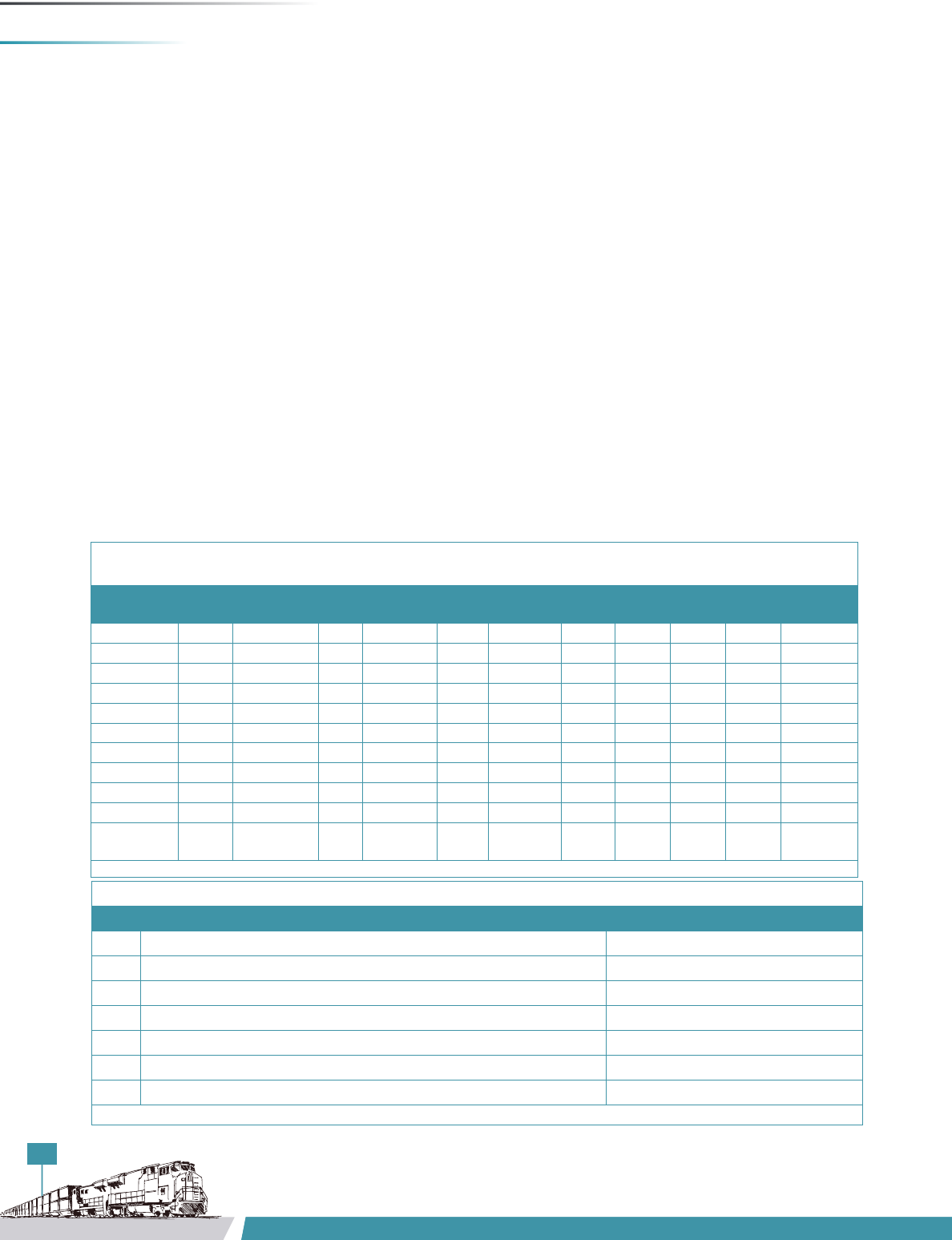
24
WORKING REPORT – FLY ASH
Table 6:Origin-DestinationTable showing rake movementof y ash byIndian Railwaysbetween 2011 and 2017
(Numberofrakes)
O/D Assam Bangladesh Bihar Jharkhand Kerala Karnataka MP Tripura UP West
Bengal
Production
Ends
Assam 2 2
Bihar 720 28 53 1 4 806
Jharkhand 499 18 121 1 1 2 642
Karnataka 1 1,066 1,067
Maharashtra 11 11
MP 3 3
Odisha 1 1
Telangana 243 243
UP 1 1 2
West Bengal 1,242 31 19 1 7 1,300
Attraction
Ends
2,464 77 193 1 1 1,320 1 1 5 14 4,076
Source: Centre for Railway Information Systems, Ministry of Railways (2016-17)
Table 7 : Major Origin Nodes in terms of Fly Ash Transport through Indian Railways
S.No. Originating Stations Avg. Rakes/Year
1 Siuri, West Bengal 180
2 ARVCementSocietyandACCLtd.(RaichurKPCL),Karnataka 178
3 NTPC Private siding, Kahalgaon 134
4 Private siding of m/s TATA Power Company Ltd. at Jojobera 105
5 KesoramCementLtd.,Raghavapuram(NTPCRamagundam) 35
6 Dhulianganga(NTPCFarakka) 28
Grand Total 660
Source: Centre for Railway Information Systems, Ministry of Railways (2016-17)
Origin-Destination Analysis
An origin-destination (O-D) analysis has also been
carried out to understand the spatial pattern of fly-ash
transportation in India by Indian Railways. As evident
from Table 6, Bihar, Jharkhand, Karnataka, and West
Bengal have the major share of originating trips for fly-
ash transport by railways, whereas Assam and Karnataka
serve as the major attraction/consumption zones where
fly ash is being transported by railways.
Further, the O-D data suggests that most of these
originating trips have been concentrated in only a few
origin stations rather than being distributed uniformly
across the country, which means transport by railways
has been restricted toselected stations.Table 7 shows
the details of such stations.
A total of 4,076 rakes of y ash have been moved by
IndianRailwaysbetween2011and2017,whichgivesan
averageof679rakesperyear.ItisevidentfromTable7
that a total of 660 rakes in a year are originating from
theabovesixstations,whichmeansthataround97%of
the total originating trips in a year are attributed to these
stations only.
Similarly, Table 8 gives us a peek into the destination
ends of the fly ash rakes carried by Indian Railways.
Again,consideringatotalaverageof679rakesperyear,
which are reaching various destinations, the destinations
of641rakesareconcentratedinonly11stations(shown
inTable8), which means that around 94% of the total
destined trips are attributed to these stations only.
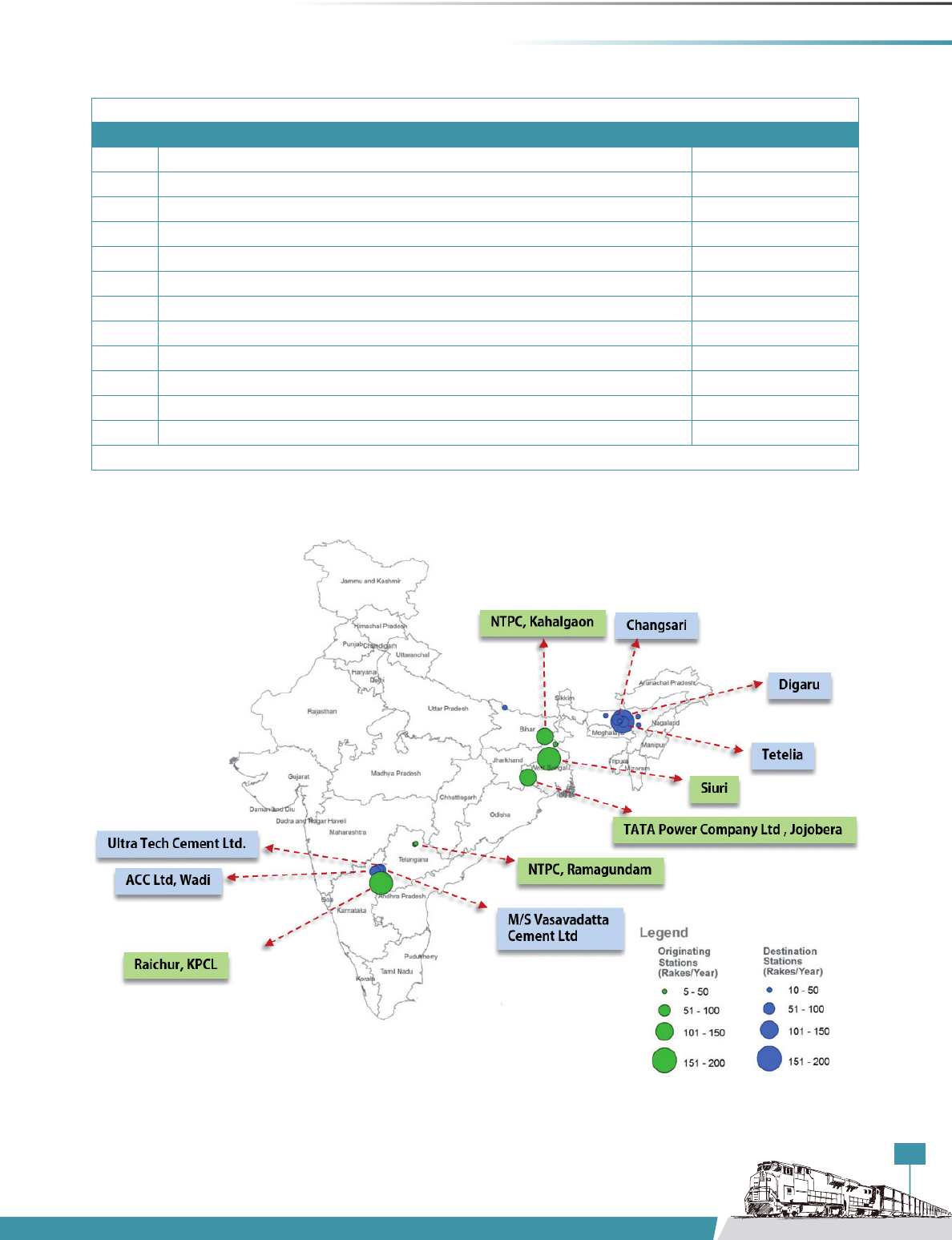
25
INCREASING RAIL SHARE IN FREIGHT TRANSPORT IN INDIA
Table 8: Major Destination Nodes in terms of Fly Ash Transport through Indian Railways
S.No. Destination Stations Avg. Rakes/Year
1 Digaru, Assam 184
2 Vasavadatta Cement Ltd, Karnataka 94
3 UltraTechCementLimited(UnitofRajashreeCementWorks),Karnataka 69
4 Tetelia, Assam 59
5 ACCLtd.Siding(Wadi),Karnataka 56
6 Chang Sari, Assam 56
7 Lanka, Assam 38
8 New Guwahati Goodshed, Assam 30
9 Raxaul Junction, Bihar 30
10 Amoni, Assam 15
11 Barpeta Road, Assam 10
Grand Total 641
Source: Centre for Railway Information Systems, Ministry of Railways (2016-17)
Figure 12 : Major Origin and Destination Nodes for Transporting Fly Ash through Railways
Source: Centre for Railway Information Systems, Ministry of Railways (2016-17) & TERI Analysis
Figure 12 shows the major origin and destination nodes
based on O-D analysis.
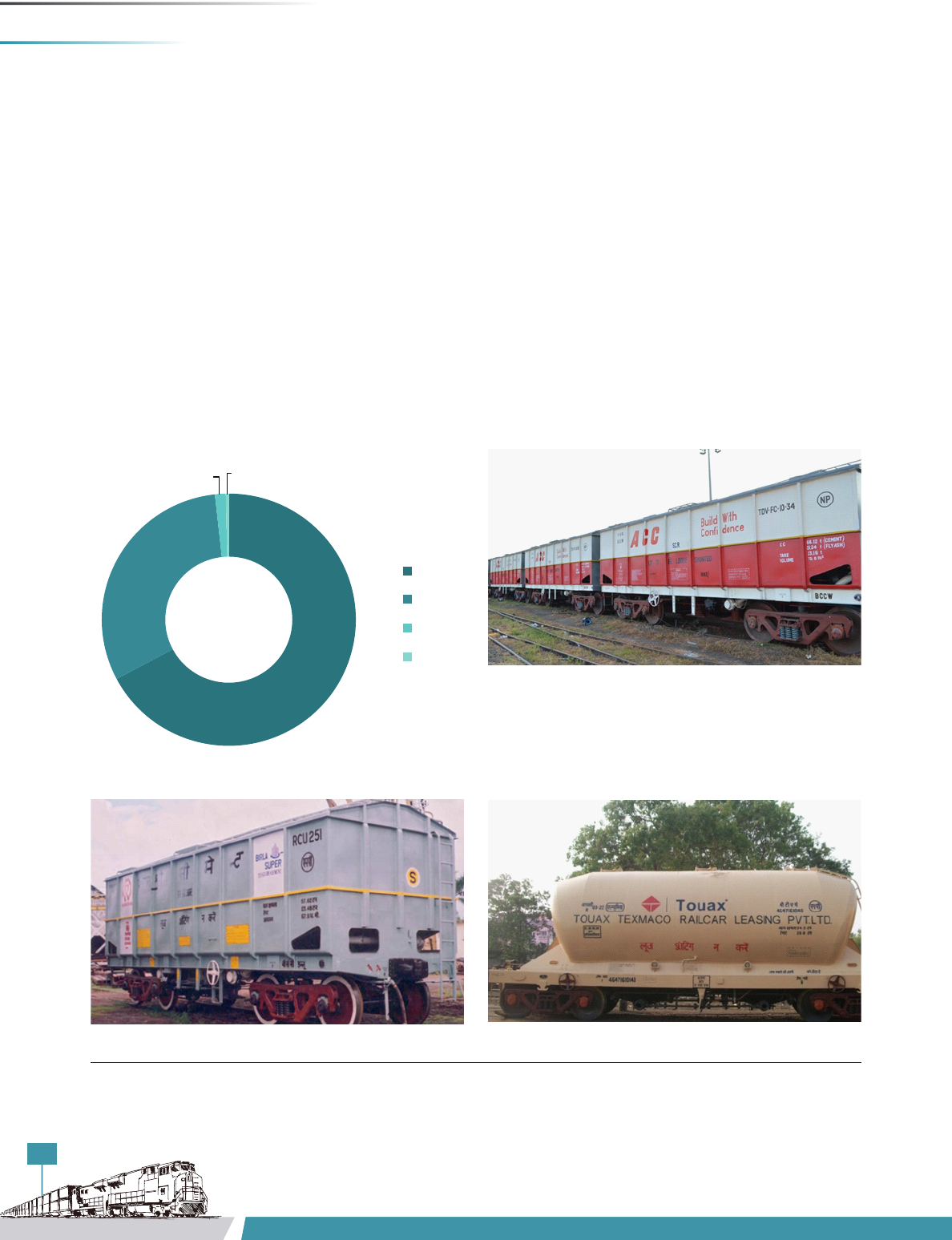
26
WORKING REPORT – FLY ASH
Rake Composition
As per the CPCB guidelines, specially designed railway
wagons should be used for transporting fly ash by rail,
but as of now, most of the fly ash is being transported
in BCN wagons (see Figure13), which are mainly used
fortransportingcement.Around67%ofthetotalyash
is transported in BCN wagons, where it is first bagged
and then loaded into the wagons. Specialized fly-ash
wagons are being used on only few circuits such as
Raichur and Ramagundam. Cement manufacturers in
these circuits have procured BCCW and BCFC wagons,
which are being used to transport fly ash from thermal
powerplantslocatedinRaichurandRamagundam(see
Figure 13: Various type of Wagons used in transporting fly ash via Rail
Source:CentreforRailwayInformationSystems,MinistryofRailways(2016-17)
Figure 14:
Covered Car “BCCW’’ wagon for bulk transport of Cement/Fly Ash
Source : Texmaco Rail & Engineering
1
Figure 16: BTAP Wagon
Source: Texmaco Rail & Engineering
3
Figure 15: BCCW wagons for bulk transport of Cement/Fly Ash
Source: Texmaco Rail & Engineering
2
1
https://www.texmaco.in/webfiles/product.php?product_cat_id=3
2
http://www.touaxtexmaco.com/content/bccw-cement-wagon
3
http://www.touaxtexmaco.com/type/tank-wagons
67.2%
31.0%
1.4%
0.4%
Share of various type of wagons used in
transporng fly ash via Rail
BCN
BCCW
BCFC
BOXN
Figures14and 15).Thesearetop-loadingandbottom-
discharge wagons. Around 31% of the total fly ash is
being transported in BCCW wagons, followed by BCFC
wagons which contribute to merely 1.4%.
Another type of wagon, which is still under the trial phase
fortransportingyash,istheBTAPwagon(seeFigure16).
This wagon is used to transport alumina powder. Trials
for bulk transportation of fly ash have been undertaken
by NTPC in BTAP wagons, but commercial operation
of such wagons is still awaited. These are top-loading
wagons and have the option for both bottom- and side-
discharge.
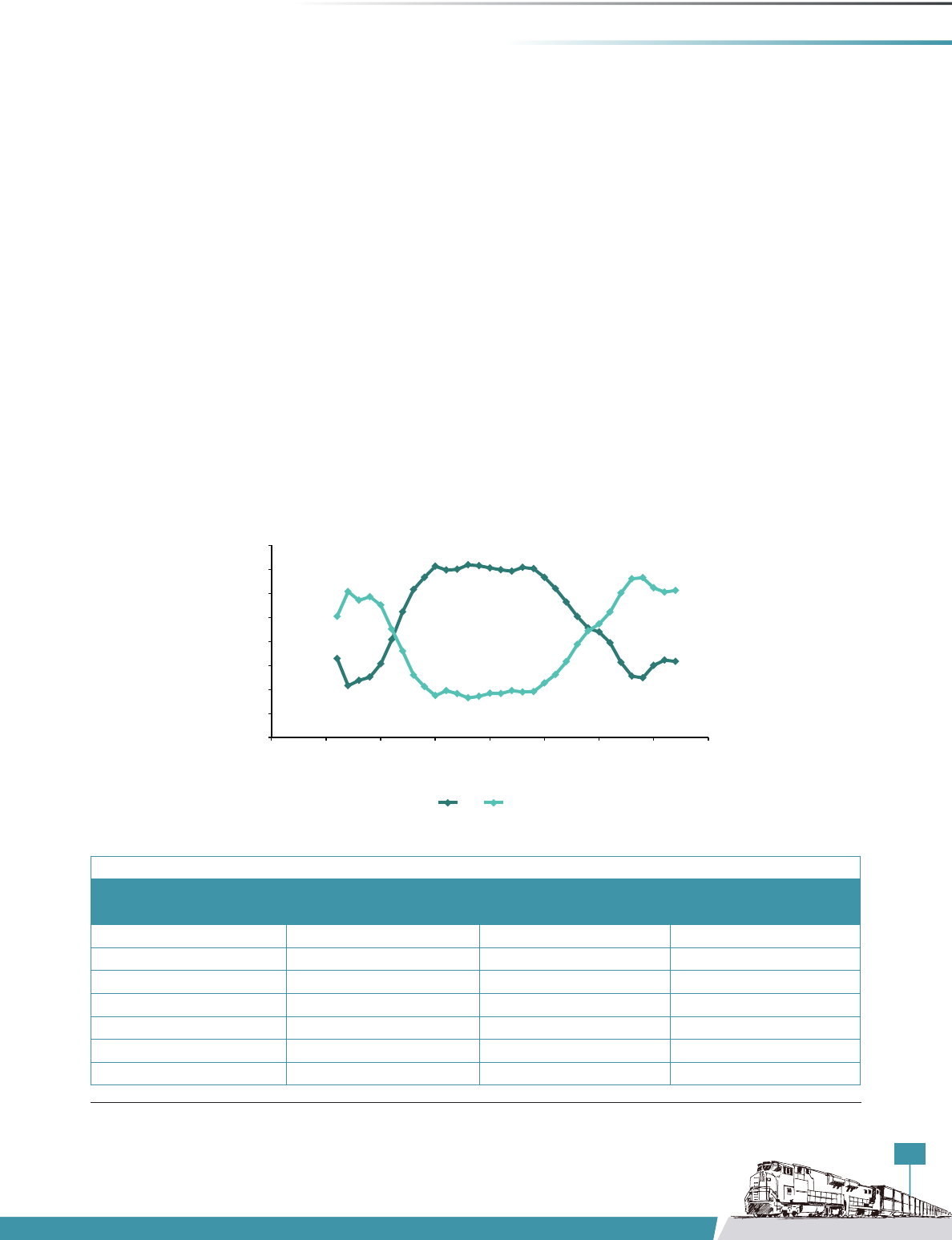
27
INCREASING RAIL SHARE IN FREIGHT TRANSPORT IN INDIA
4
See https://www.downtoearth.org.in/news/cpwd-no-fly-ash-zone-11910
Figure 17: Share of PPC cement and OPC cement in total cement production
Source: Cement Manufacturers Association (CMA)
0
10
20
30
40
50
60
70
80
1975 1980 1985 1990 1995 2000 2005 2010 2015
Percentage
Year
Changing Shares of OPC & PPC
OPC PPC
Fly-Ash Transport in Cement
Industry
As mentioned earlier also, cement industry is the
largest consumer of y ash in the country (see Figure
9). Fly ash can either be blended with cement at the
time of production (Portland Pozzolana Cement [PPC])
or added as an admixture while mixing concrete. This
is done because of fly ash’s pozzolanic behaviour.
Pozzolanic materials are those substances which are
not cementitious in nature but contain certain chemical
constituents. These materials, once combined with
lime and water at ordinary temperature, can develop
cementitious properties. Pozzolana cement is obtained
by blending a mixture of clinkers, up to 35% of pozzolana
(forex-y ash), and the stipulated quantity of gypsum.
The strength of pozzolana is comparable to Ordinary
PortlandCement(OPC)andtheconcreteproducedusing
fly ash has shown a better performance and resistance
towards corrosion and chemical attack.
With nearly 280 million tonnes of cement production
in 2016–17 (Ministryof Commerceand Industry 2017),
the Indian cement industry is the second-largest in the
world. While cement production has increased steadily,
its composition in terms of OPC and PPC has changed
signicantly(seeFigure17).Intheperiodpriorto1986,
the use of PPC in cement production was significant,
for instance, in 1983, PPC constituted 80% of the total
cement produced. PPC production came down to less
than 20% in 1990 and remained at this level for almost a
decade. The downslide was a fallout of the Central Public
WorksDepartment’s(CPWD)circularbanningtheuseof
PPC
4
. The ban was subsequently rolled back in 2004 and
PPC production increased to more than 50% of the total
cement production in 2006.
Table 9 gives the breakup of the cement produced from
2000–01to2007–08,alongwithPPCproduction.
Table 9: PPC’s share in the total cement production
Year Cement Production
(Million Tonnes)
PPC Production
(Million Tonnes)
% of Total Production
2000-01 93.6 24.5 26.2
2001-02 102.4 32.3 31.5
2002-03 111.4 43.1 38.7
2003-04 117.5 52.1 44.4
2004-05 127.6 60.2 47.2
2005-06 141.8 74.0 52.2
2006-07 155.7 93.6 60.1
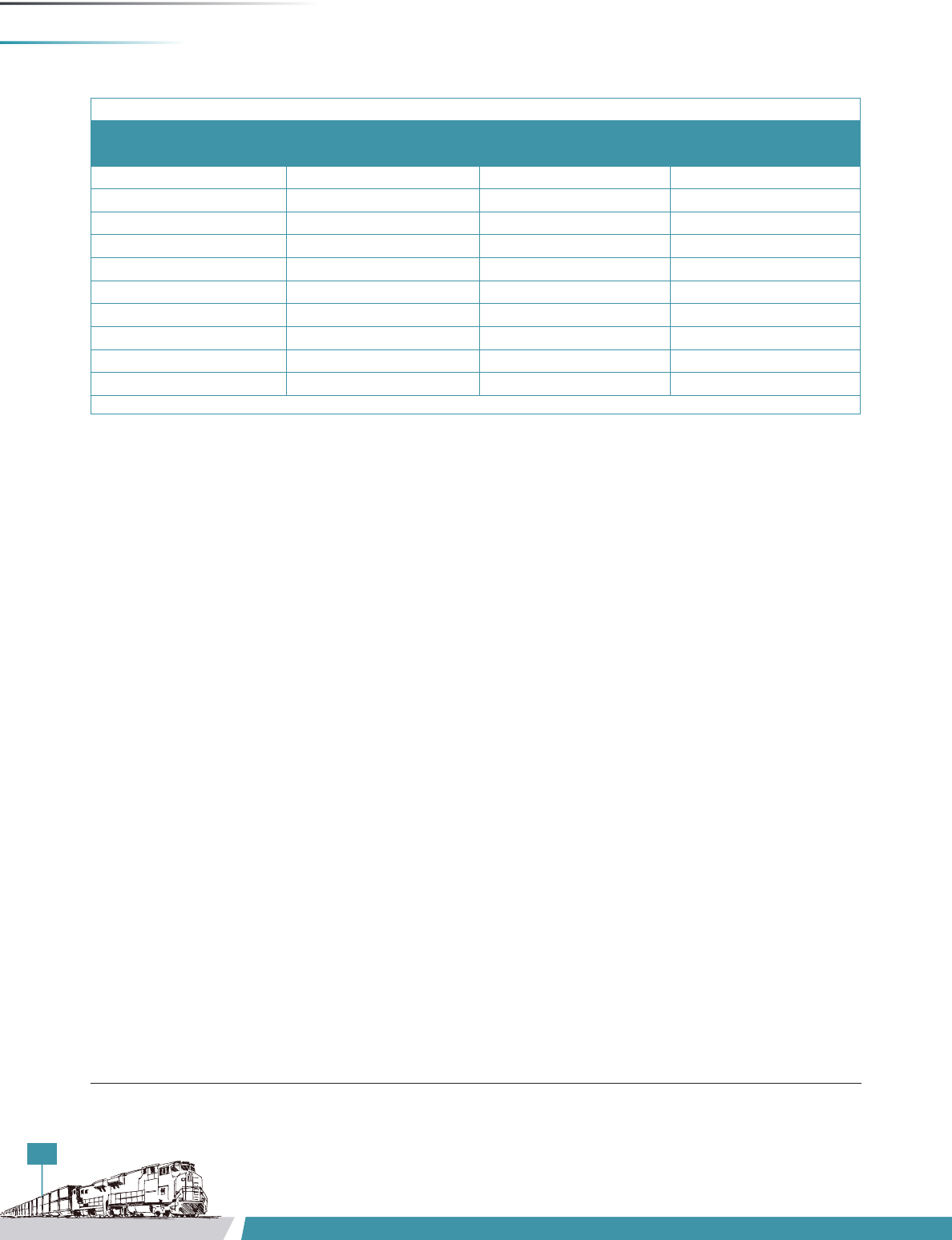
28
WORKING REPORT – FLY ASH
5
242 Cement Plants as provided by Cement Manufacturers Association
6
142 Thermal Power Plants as mentioned in CEA Report, 2016-17
Due to the unavailability of data, the updated figures
for PPC’s share in recent years have not been presented
here, but as per the discussion with stakeholders,
PPC’s share in cement production at present is likely
to be somewhere around 65%. Considering the 280
million tonnes of cement production in 2016–17, PPC
production can be pegged at around 182 million
tonnes. At a rough estimate of 20% of fly-ash blending
in producing PPC-grade cement, the total amount of fly
ashusedin2016–17bythecementindustrytoproduce
182 million tonnes of PPC would be about 36.4 million
tonnes, which is close to the total fly-ash consumption
bythe cement industry in thesame year (seeTable 4).
Hence,theshareofPPCproduction(65%)seemsmore
orlessaccuratefor2016-17.Inthecomingyears,withthe
Indian economy doing well, the per capita consumption
of cement is also likely to increase, putting more
pressure on cement production. Hence, there is a clear
possibility that PPC production will increase, and so will
the demand for fly ash. Therefore, the cement industry is
expected to remain the single-biggest consumer of fly
ash in the coming years.
Figure 18 shows the distribution of cement plants
5
as
well as thermal power plants
6
in India. Cement plants, the
largest consumers of fly ash, are generally located close
to limestone deposits, which is the basic raw material
for cement production. In India, there are several such
clusters of cement plants around large limestone
deposits.
Many cement manufacturers have established split-
grinding units close to the consumption centres, where
the clinker brought from the mother plant are passed
through the grinding stage, bagged, and dispatched to
the market. Some of the cement manufacturers have
established split-grinding units close to TPS, so that fly ash
can be utilized without entailing a high transportation
cost. The proximity of these cement plants has been
calculated by plotting a 100-km buffer from the TPS.
As Figure 18 shows, of the 242 cement plants plotted
onthemap(actualnumbersmightvaryslightlydueto
theunavailabilityofafewplantlocations),172cement
plants were located within a distance range of 100 km
from TPS. Further, if we increase this buffer up to 300 km
(seeFigure19),thisnumberincreasesfrom172to225,
which means that a total of 53 cement plants are located
within a distance range of 100–300 km from TPS. This
indicatesthataround71%ofthetotalcementplantsare
located within a 100-km buffer of thermal power plants,
and around 22% of cement plants are located within a
buffer of 100–300 km.
A few cement plants are also located in isolated places.
It is clear from Figure 19 that the spatial distribution
of cement-manufacturing units follows the spatial
patterns of fly-ash producers, i.e. TPSs, for example, the
cement plants located near the Singrauli, Anpara, and
Vindhyachal cluster of power plants and the cement
plants located near Kahalgaon, Farakka, Mejia, and
Kolaghat.
Table 9: PPC’s share in the total cement production
Year Cement Production
(Million Tonnes)
PPC Production
(Million Tonnes)
% of Total Production
2007-08 168.3 111.2 66.1
2008-09 181.6 120.8 66.5
2009-10 160.8 100.2 62.3
2010-11 216.3 102.4 60.5
2011-12 230.3 110.1 61.2
2012-13 235.1 - -
2013-14 256.0 - -
2014-15 276.9 - -
2015-16 283.5 - -
2016-17 280.0 - -
Source: Cement Manufacturers Association (CMA)
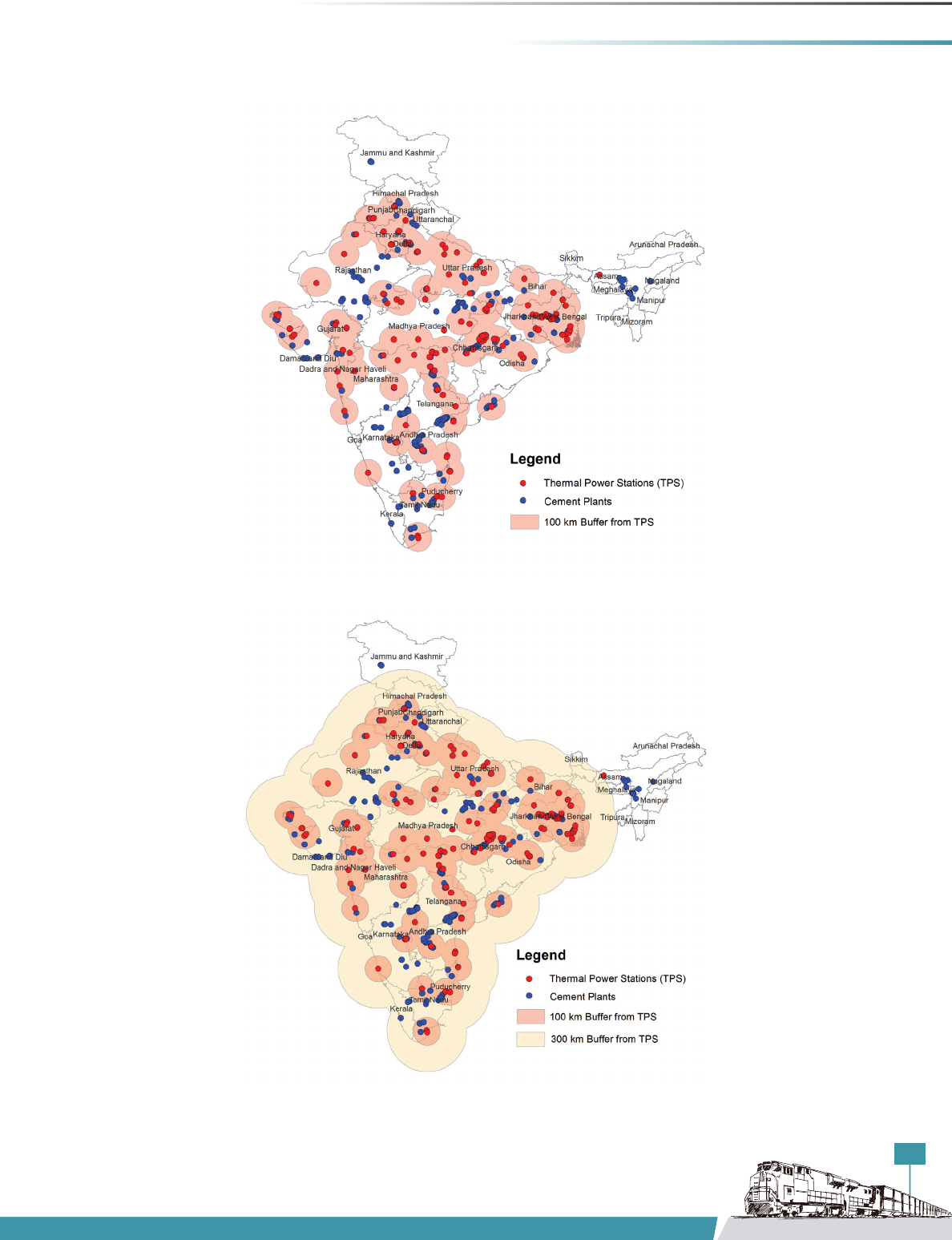
29
INCREASING RAIL SHARE IN FREIGHT TRANSPORT IN INDIA
Figure 19:SpatialdistributionofCementplantsinIndiaalongwiththeThermalPowerPlants(BufferRange–300km)
Source: Report on Fly Ash Generation, CEA (2016–17), and CMA
Figure 18:SpatialdistributionofCementplantsinIndiaalongwiththeThermalPowerPlants(BufferRange–100km)
Source: Report on Fly Ash Generation, Central Electricity Authority (2016-17) & Cement Manufacturers Association

30
WORKING REPORT – FLY ASH
Opportunity of Fly-Ash Transport by
Rail
As discussed earlier also, the cement industry is likely
to be the main consumer of fly ash in the coming years.
Therefore, the report focusses on the possibilities of
transporting fly ash by rail from power plants to cement
plants. Presently, almost all fly-ash transportation
happens by road. The modal share of railways in
transportingyashwasonly2.3%in2016–17.Thermal
power plants generally construct silos for intermediate
storage of fly ash, from where it is transported to cement
plants either by bulkers or rail. Discussions with the
stakeholders from ACC Cement, NTPC, and the CMA
revealed that the major reasons for the use of road
transport are lower capital investment and complete
control over the transportation chain. These companies
have purchased road tankers and given them on labour
contract to agencies for provision of driver and other
manpower. They have also made capital investment at
both ends for the development of loading and unloading
facilities as well as the creation of silos for storage.
Some of these companies have entered into long-term
agreements with power plants for the supply of fly ash
(Nanduri, 2008). As the movement of y ash in road
tankers is expensive and unsuitable for large quantities,
several cement manufacturers have also located clinker-
grinding units close to the power plant.
To understand if it is feasible to transport fly ash by rail, it
is important to relate the patterns of fly-ash production
with the consumption centres, and also understand the
logistical requirements to move fly ash in bulk quantities.
Figure 7 shows that because coal-based power plants
are spread across the country, fly-ash generation is not
evenly distributed. Because of geographical advantage,
large coal-based plants are located in regions of Uttar
Pradesh, Jharkhand, Chhattisgarh, and West Bengal.
Other concentrations can be observed in Telangana and
the Telangana–Maharashtra border in the Wardha Valley
Coalfield. Some major power plants are also located
in Gujarat, Odisha, Bihar, and Andhra Pradesh. For a
better understanding these thermal power plants can
be divided into the following clusters throughout the
country:
Cluster 1: Five coal-based power plants with large
capacities are located in a cluster known as the Singrauli
region at the border of Uttar Pradesh and Madhya
Pradesh. These power plants are Obra, Rihand, Singrauli,
Anpara, and Vindhyachal. They have a combined fly-ash
generation of around 20 million tonnes per year. In the
same region, power plants with slightly lower capacities
are also located at Tanda, Panki, Unchahar, and Parichha.
Cluster 2: In Bihar and West Bengal, the major power
plants are Kahalgaon, Farakka, Mejia, and Kolaghat. The
power plants at Kahalgaon and Farakka alone produce
around 8 million tonnes of fly ash per year.
Cluster 3: In Chhattisgarh, the major power plants are
NTPC Sipat and Korba. Few other state-owned and
private sector plants like Jindal Thermal Power Plant and
others are also located in the same cluster. These power
plants produce around 15 million tonnes of fly ash per
year.
Cluster 4: In the Telangana, Andhra Pradesh, Karnataka,
and Maharashtra cluster, large coal-based power plants
are Ramagundam, Kothagudem, Vijayawada, Simhadri,
Rayalaseema, Raichur, Chandrapur, and Tirora. The
power plants at Ramagundam, Vijayawada, and Raichur
produce more than 10 million tonnes of fly ash per year.
Cluster 5: In the Gujarat and Rajasthan cluster,
Wanakbori, Ukai, Kota, JSW Barmer, and Suratgarh are the
major power plants which produce significant quantities
of fly ash in the western part of India.
Cluster 6: In the Delhi, Punjab, and Haryana cluster,
power plants located at Dadri, Jhajjar, and Hissar produce
significant quantities of fly ash.
Two case studies from the aforementioned clusters have
been selected and presented here to further understand
the various aspects involved in transporting fly ash by
rail and road.
Case Study I
Ramagundam Region
The southern region consisting of states like Telangana,
Andhra Pradesh, and Karnataka houses major power
plants like Ramagundam, Vijayawada, and Raichur, which
produce more than 10 million tonnes of fly ash per
year.In2007,aconcertedeffortwasmadebyRailways,
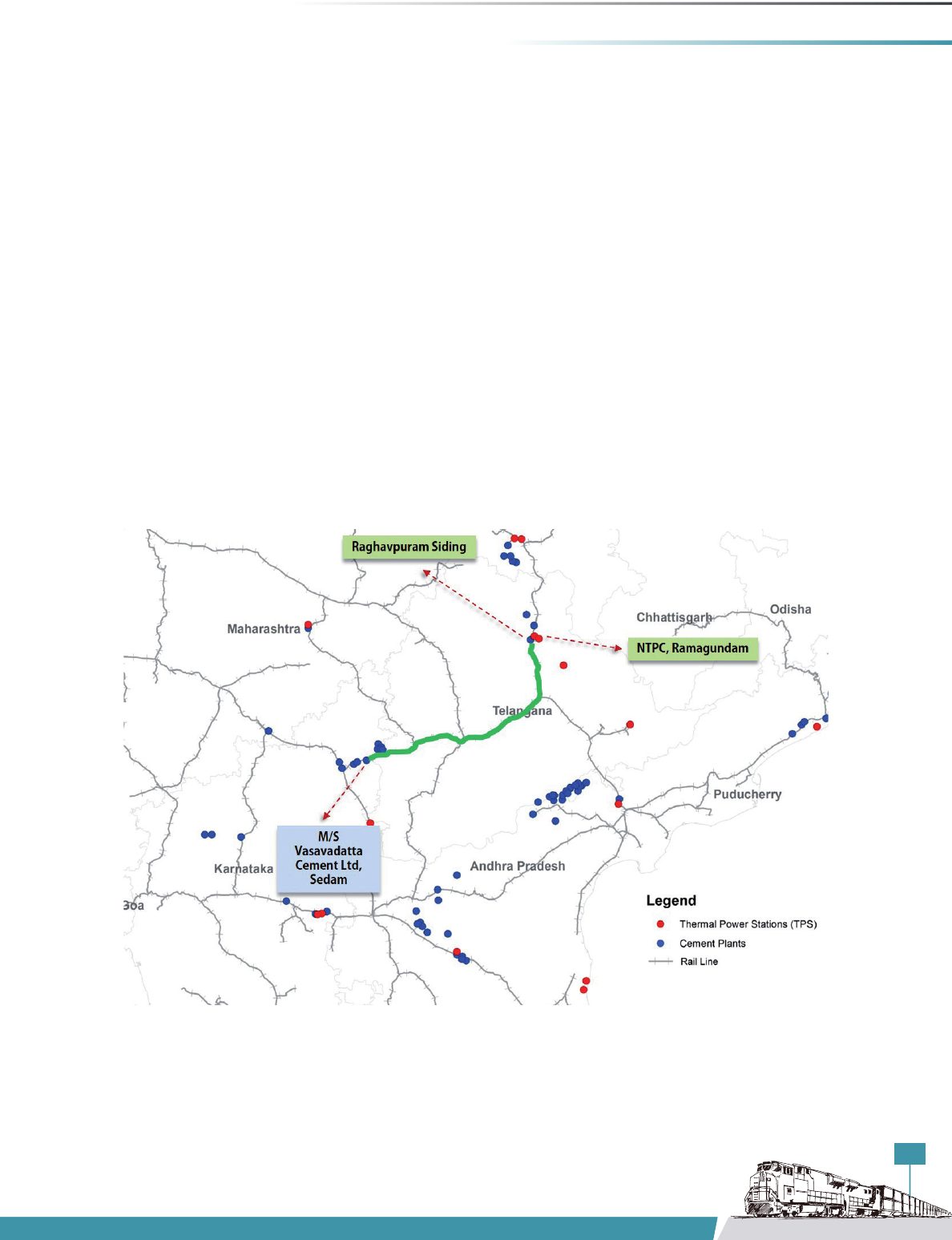
31
INCREASING RAIL SHARE IN FREIGHT TRANSPORT IN INDIA
Rs 1,225 per tonne, but after the introduction of rail
movement, this cost was reduced to Rs 363 per tonne in
thedistanceslabof377km(Nanduri,2008).Therailway
wagons were initially provided by the South Central
Railway by way of in-house modification of the existing
surplus tank wagons (see Figure 21) on the condition
that these wagons would be used only until the cement
plants procure their own specialized wagons. Also,
loading and unloading facilities were created at both
sidings. About 210 surplus four-wheeler tank wagons
were deployed by the South Central Railway for moving
fly ash between Raghavapuram siding and Sedam
(Nanduri, 2008). The wagons used to transport y ash
were only provided as a temporary solution, as Railways
did not have many surplus wagons for modification.
In the long term, Indian Railways/cement companies/
power corporations will have to consider the option of
investing in pneumatic hopper-type wagons.
NTPC, and cement plants to transport fly ash by rail
mode. Kesoram Cement Company, Raghavapuram, a
subsidiary of Vasavadatta Cements, Sedam, entered into
an agreement with NTPC, Ramagundam, to take away fly
ash from NTPC silos by road tankers to Raghavapuram
siding, and from there, to Vasavadatta siding at Sedam
byrailwaywagons,coveringadistanceof377km (see
Figure 20). A pilot study conducted by South Central
Railway for this arrangement showed benefits for all
the parties involved. While cement plants benefitted
from the cheaper transport cost, Indian Railways was
successful in capturing and generating revenue by
capturing the traffic, which would have otherwise been
transported by road.
Prior to this agreement, the entire quantity of fly ash was
transported by road though bulker trucks. Transporting
fly ash through road would cost cement plants around
Figure 20: Map showing the rail connectivity of fly-ash transportation from Raghavapuram siding to Vasavadatta Cements, Sedam
Source: Report on Fly Ash Generation, CEA (2016–17), CMA, and TERI analysis
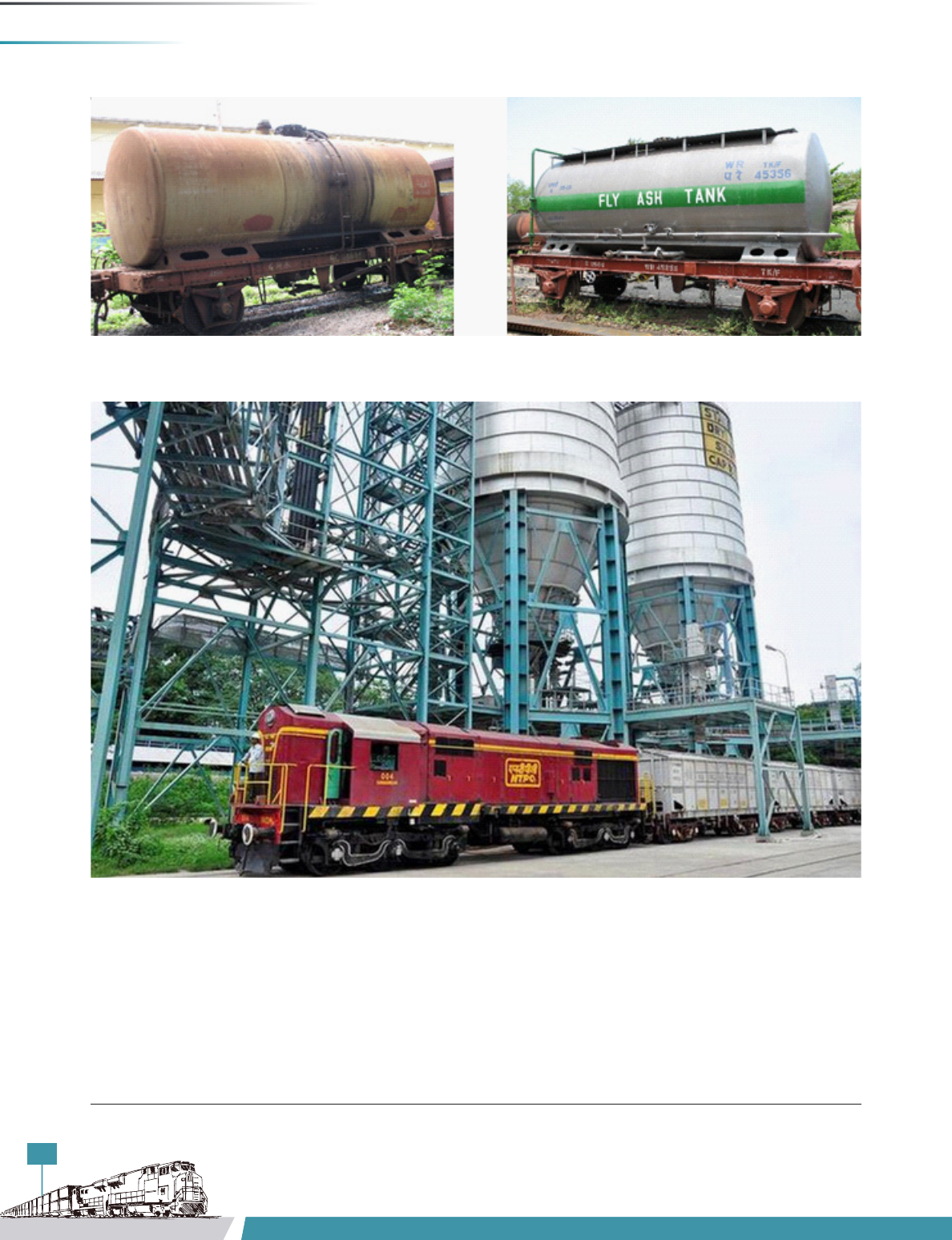
32
WORKING REPORT – FLY ASH
Figure 21: Railway wagons before and after modification
Source: Report on fly-ash utilization by cement industry (Nanduri, 2008)
Figure 22: Fly-ash loading at NTPC, Ramagundam
Source: The Hindu
7
7
See https://www.thehindu.com/news/cities/Hyderabad/high-demand-for-ntpc-fly-ash/article23282313.ece.
The pilot study has also pointed out the benefits,
specifically to railways, by fly-ash transportation from the
Raichur Thermal Power Station to Vasavadatta Cements,
Sedam(seeFigure23).
As mentioned in the pilot study report, benefits to
railways on both the aforementioned routes have been
listed in Tables 10 and 11 for a better understanding.
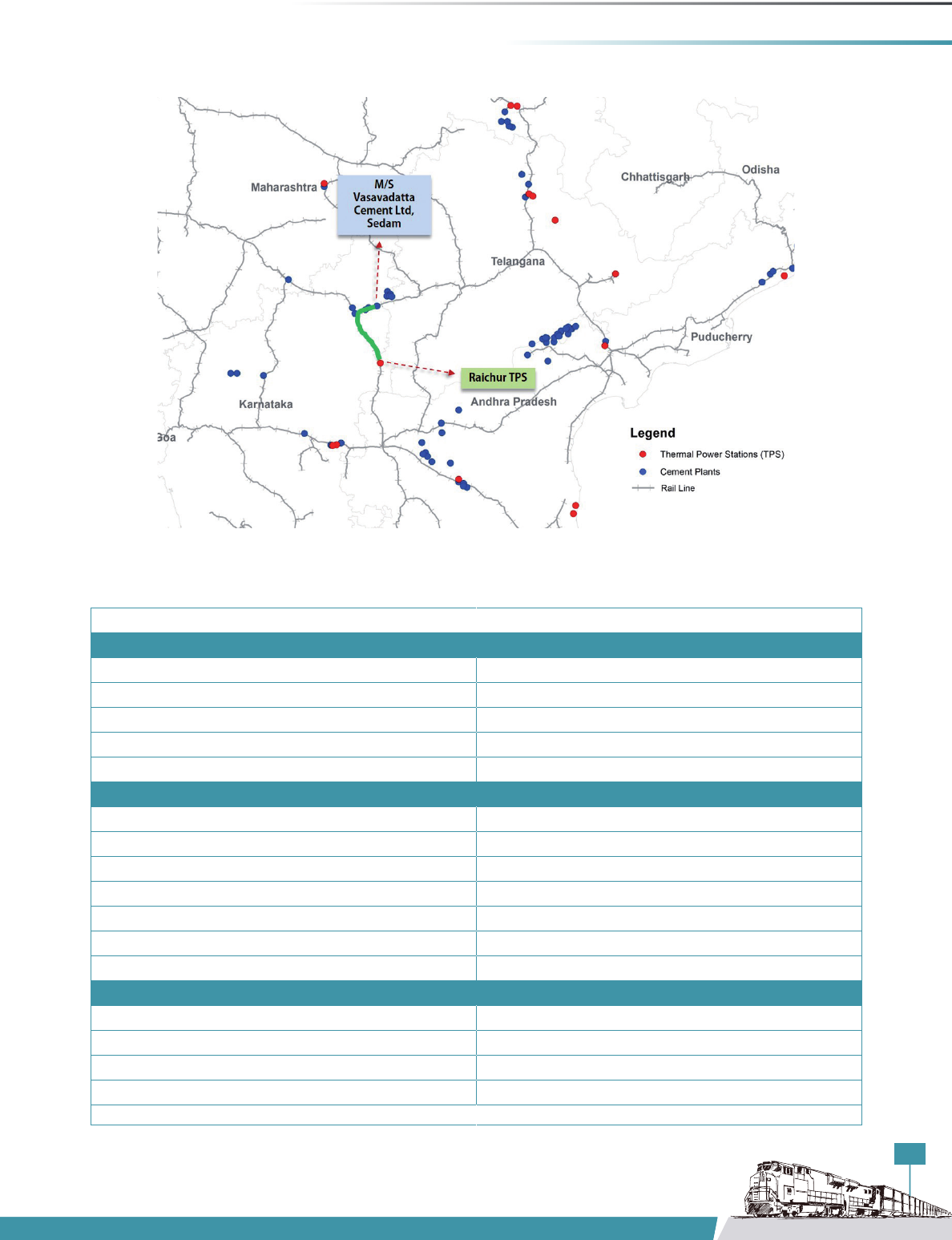
33
INCREASING RAIL SHARE IN FREIGHT TRANSPORT IN INDIA
Figure 23: Map showing rail connectivity of fly-ash transportation from the Raichur Thermal Power
Station to Vasavadatta Cements, Sedam
Source: Report on Fly Ash Generation, CEA (2016–17), CMA, and TERI analysis
Table10:CostofmovingyashfromRaghavapuramtoSedambyrail(2007–08)
Particulars Details
No. of wagons per rake 40
No. of rakes to be loaded 180
Averagequantityperrake(metrictonnes) 2,400
Totalquantitytobemoved(metrictonnes) 4,32,000
Wagon days per year 14,600
Cost of moving fly ash
Distance 377km
NTKM per year 23,40,49,140
Tare tonne km per year 5,23,03,140
Total GTKM 28,63,52,280
Line-haul cost in 2005–06 per 1000 GTKM in Rs 195
Operational cost in Rs 5,58,38,695
Total distributed costs as derived ratio in Rs 8,93,41,911
Benefit to Railways
Revenue per tonne km in Rs 363
Total revenue in Rs 15,68,16,000
Surplus per year in Rs 6,74,74,089
Surplus after 15% freight concession 43,951,689
Source: Report on fly-ash utilization by cement industry (Nanduri, 2008)
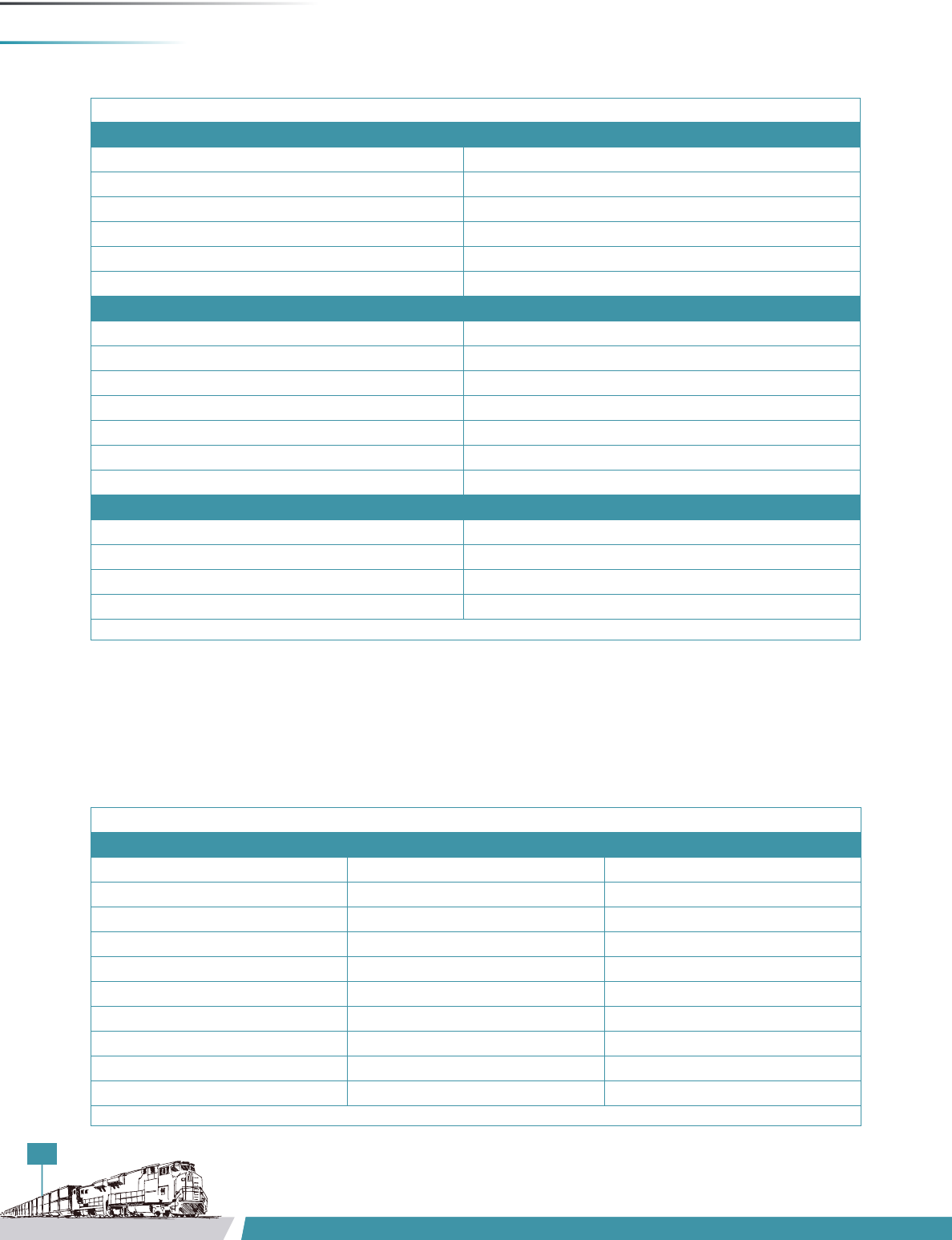
34
WORKING REPORT – FLY ASH
Table11:CostofmovingyashfromRaichurtoSedambyrail(2007–08)
Particulars Details
No. of wagons used 200
No of wagons per rake 40
No. of rakes to be loaded 365
Average quantity per rake 2,400
Total quantity to be moved 8,76,000
Wagon days per year 73,000
Cost of moving fly ash
Distance 150 km
GTKM per year 18,88,32,750
Tare tonne km per year 0
Total GTKM 18,88,32,750
Line-haul cost in 2005–06 per 1000 GTKM 195
Operational cost in Rs 3,68,22,386
Total distributed costs as derived ratio in Rs 5,89,15,818
Benefit to Railways
Revenue per tonne km 140
Total revenue in Rs 15,68,16,000
Surplus per year in Rs 9,79,00,182
Surplus after 15% freight concession 74,377,782
Source: Report on fly-ash utilization by cement industry (Nanduri, 2008)
Case Study II
Singrauli Region
Geographically spread across the Singrauli district
of Madhya Pradesh and Sonebhadra district of Uttar
Pradesh, the Singrauli region is known as the power
capital of India. Several coal-based thermal power plants
are located in this region with the installed capacity of
more than 20,000 MW of power generation. Table 12
shows the details of the power plants in this region.
Table 12: TPS in Singrauli Region
S. no. Name of TPS Capacity (MW)
1 NTPC Vindhyachal 4,760
2 NTPC Singrauli 2,000
3 Hindalco Renusagar 750
4 Sasan Ultra Mega Power Project 3,960
5 Anpara 2,630
6 Hindalco Mahan 1,200
7 Essar Power 1,200
8 NTPC Rihand 3,000
9 Obra 1,194
Total 20,694
Source: Report on Fly Ash Generation, CEA (2016–17)
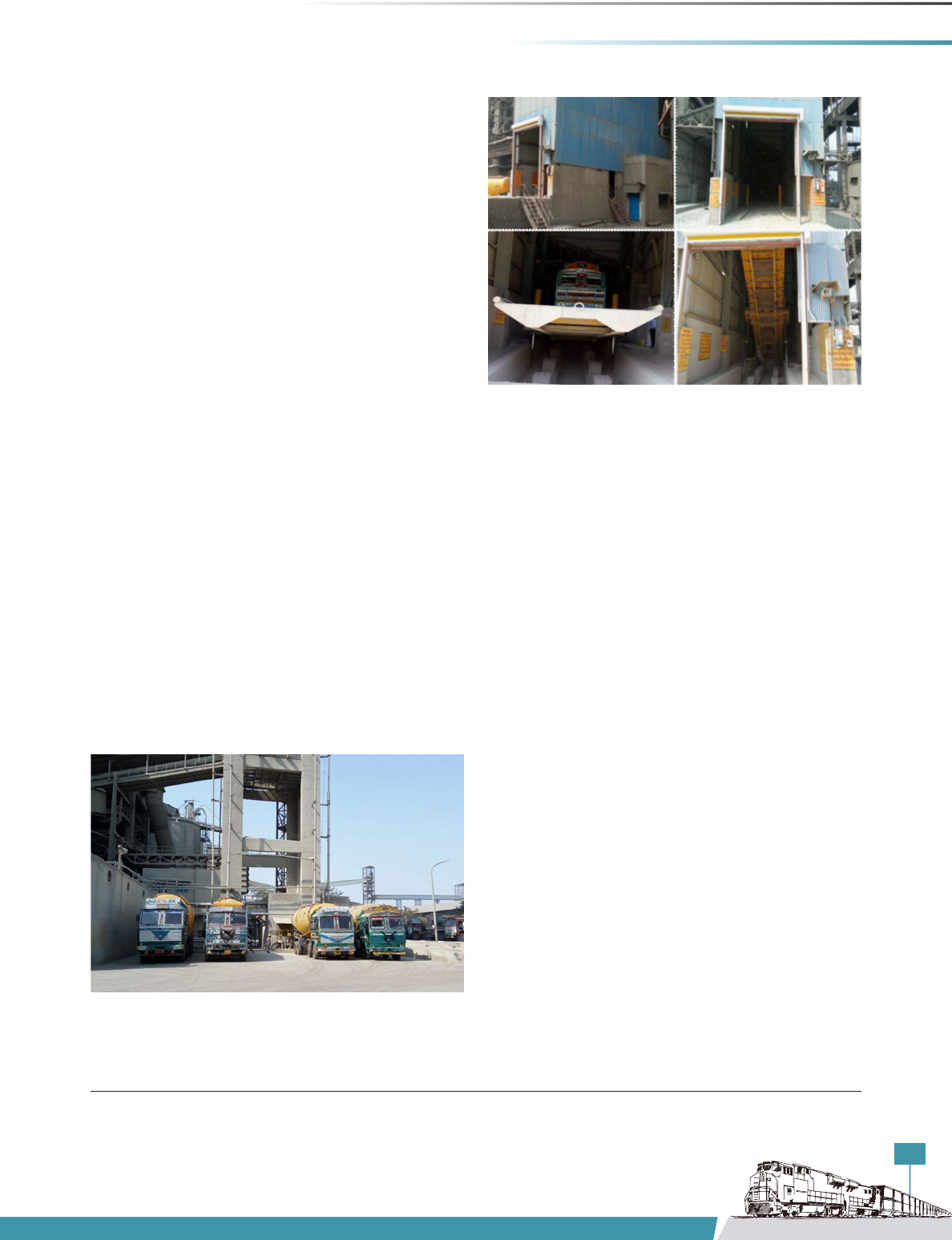
35
INCREASING RAIL SHARE IN FREIGHT TRANSPORT IN INDIA
Power plants in the Singrauli region generate around
25 to 30 million tonnes of fly ash per year. However, the
ash-utilization levels of these power plants have been
considerably low over the years. As per the CEA report
(2016–17), NTPC Vindhyachal, Obra, and Rihand had
utilizationlevelsof23.5%,27.6%,and15.5%,respectively,
whereas NTPC Singrauli and Anpara had utilization levels
of only 9.2% and 0.4%, respectively.
The location of fly-ash generation contributes
significantly to its gainful utilization. Although there
are many coal-based thermal power plants in the
Singrauli region, the remote location of these plants
from the ash-consumption belt restricts the utilization
of ash generated in the region. The nearest cities from
the Singrauli region are Rewa and Varanasi, which are
located at a distance of 225 km and 250 km, respectively.
Providing fly ash to the cement industries of the Rewa–
Satna–Katni region is a major way of ash utilization for
the power plants of the Singrauli region. The total peak
demand of fly ash from these cement plants is around
25,000 tonnes per day, whereas the Singrauli region
generatesmorethan70,000tonnesofyasheveryday
(Narayan&Mangla,2016).Therefore,alargequantityof
fly ash remains unutilized and is being disposed of in ash
dykes.
Fly ash is being provided to the cement industries of the
Rewa–Satna–Katni region through closed bulkers and
trucks. Although power plants and cement plants have
the facility of pneumatic loading and unloading through
road bulkers and trucks (see Figures 24 and 25), some
modifications are required in order to develop loading
and unloading facilities for the rail mode.
As far as specialized wagons are concerned, trials of
modified BTAP wagons for transporting fly ash are
going on. Once approved, it will help in transporting fly
ash by rail in an environmentally safe manner. Railway
freight charges are less than 50% of the cost of fly-ash
transportationbyroad(Narayan&Mangla,2016).Hence,
fly-ash transportation by rail will not only encourage the
cement plants of Rewa–Satna–Katni to take more fly ash
from TPS, but will also encourage the bulk movement of
fly ash to distant consumers in an economic manner.
Estimation of Costs and Benefits of Fly-Ash
Transportation
The transportation cost of any commodity plays a
significant role in the marketability of the product. The
transportation cost usually varies according to the type
of mode used and distance travelled. At present, freight
charges for transporting fly ash through bulkers and
trucks range between Rs 800 per tonne and Rs 1,200 per
tonne, (Narayan & Mangla, 2016), which is signicantly
Figure 24: Pneumatic unloading facility for bulker trucks at Prism
Cement, Satna
Source: Fly Ash Utilization 2018 – Conference
8
Figure 25: Mechanized fly-ash unloading by truck tippler at Prism
Cement, Satna
Source: Fly Ash Utilization 2018—Conference
9
8
See http://flyash2018.missionenergy.org/presentations/Prism%20Cement.pdf.
9
See http://flyash2018.missionenergy.org/presentations/Prism%20Cement.pdf.
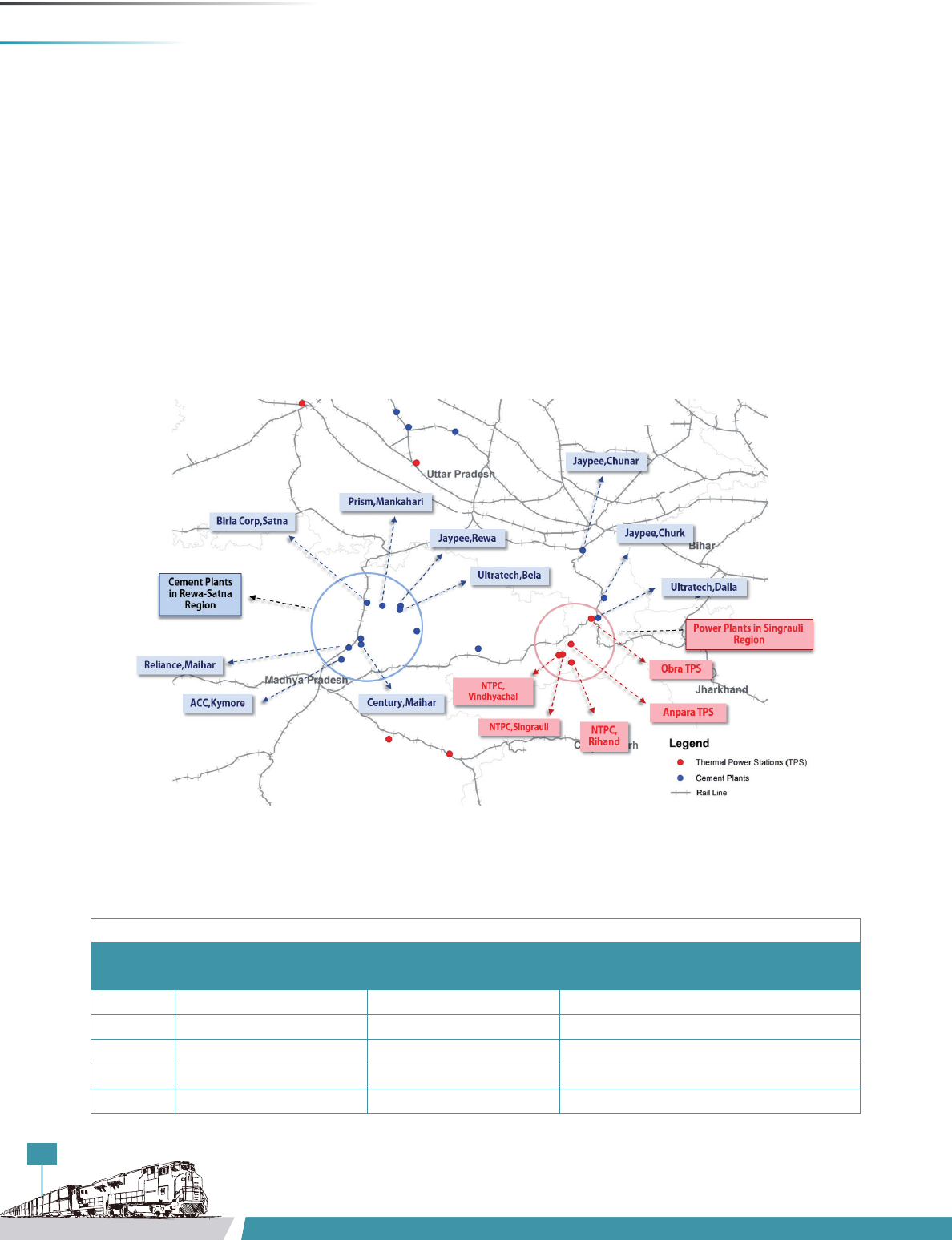
36
WORKING REPORT – FLY ASH
high when compared to transportation charges through
the rail mode. Indian Railways has classified fly ash as
Class-120 material for full rake load, and as per the current
rates, railway freight charges for transporting fly ash to a
distanceof301–350km(sincemostofthecementplants
of the Rewa–Satna–Katni region are within 250–350 km
ofpowerplants)shallbeintherangeofRs393pertonne
to Rs 419 per tonne. High freight charges, which at present
are borne by users, can limit the substantial utilization of
fly ash. The analysis presented in this section is restricted
to fly-ash movement between the cement plants located
in the Rewa–Satna region and the thermal power plants
locatedintheSingrauliregion(seeFigure26).
Demand Assessment
Only cement plants with rail connectivity have been
selected to estimate the fly-ash demand since these are
the potential buyers to whom fly ash can be transported
by rail, provided they have the required infrastructure
in place for unloading the fly ash from rail. Table 13 lists
selected cement plants. The average annual capacity
utilization for previous years has been used to project
the current PPC production in these plants. It is assumed
that on an average, the quantity of fly ash required to
produce PPC is 30% of the total PPC production.
Figure 26: Map showing the location of TPS in the Singrauli region and cement plants in the Rewa–Satna region
Source: Report on Fly Ash Generation, CEA (2016–17), CMA, and TERI analysis
Table 13: Cement plants selected to estimate the annual fly-ash demand
Cement plant Location Estimated annual fly-ash demand
(in million tonnes)
1 ACC, Kymore Katni, MP 0.518
2 UltraTech, Dalla Sonebhadra, UP 0.117
3 UltraTech, Bela Rewa,MP 0.434
4 Jaypee, Chunar GU Mirzapur 0.487
5 Jaypee, Churk GU Mirzapur 0.012
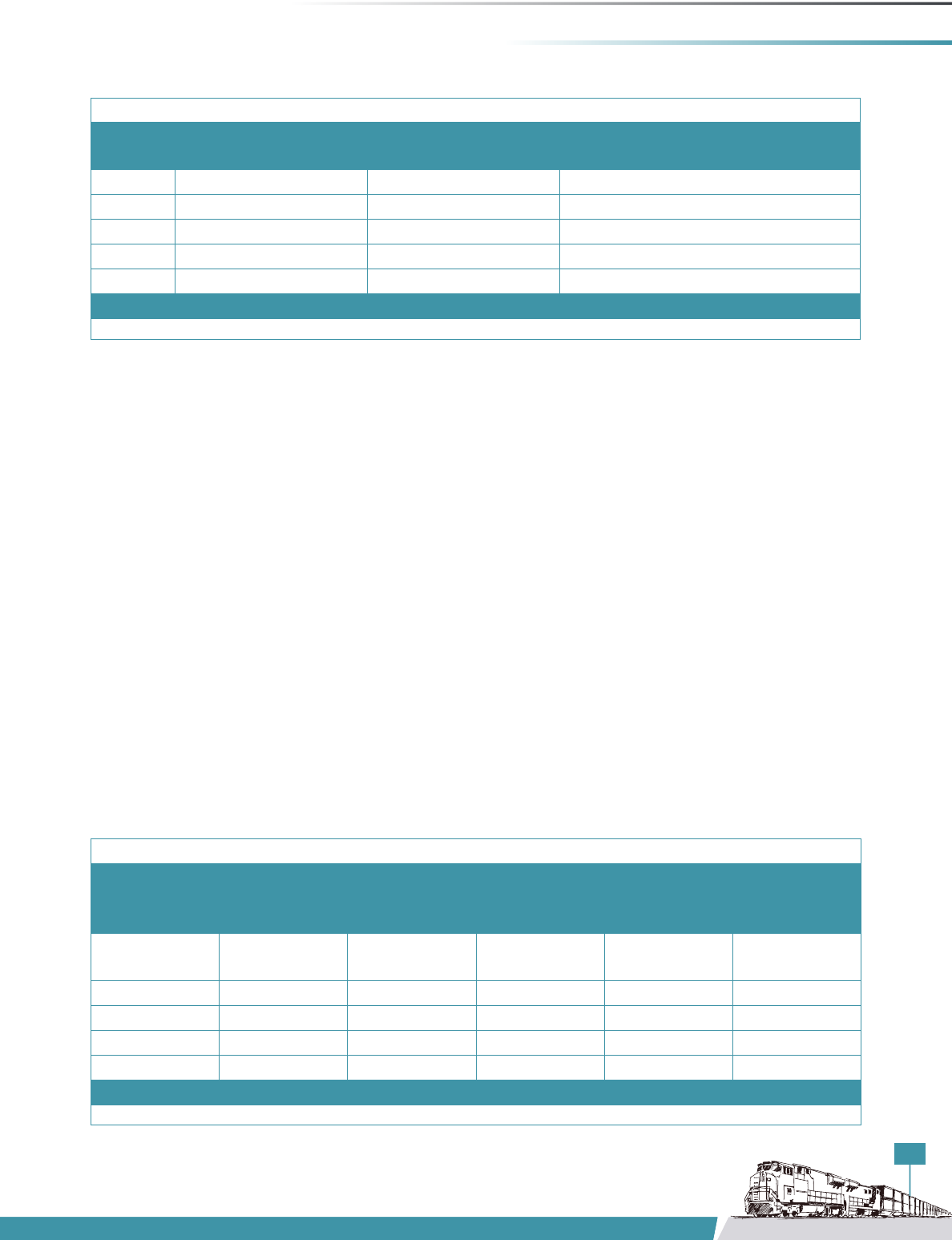
37
INCREASING RAIL SHARE IN FREIGHT TRANSPORT IN INDIA
Table 13: Cement plants selected to estimate the annual fly-ash demand
Cement plant Location Estimated annual fly-ash demand
(in million tonnes)
6 Jaypee, Rewa Rewa,MP 0.603
7 Reliance, Maihar Satna, MP 1.015
8 Century, Maihar Satna, MP 0.451
9 Birla Corp, Satna Satna, MP 0.416
10 Prism, Mankahari Satna, MP 1.337
Total 5.39
Source: TERI analysis
Fly-Ash Availability
As discussed earlier also, cement plants located in the
Rewa–Satna region are the major consumers of fly
ash available at power plants in the Singrauli region.
Assuming that all the fly-ash demand has to be met
through the fly ash available in the Singrauli region,
fly-ash availability has been calculated by selecting
major fly-ash-producing plants in the region. Table 14
represents the availability of fly ash in major TPS in the
Singrauli region.
Estimation of Transport Cost
Transportation costs for moving fly ash from the Singrauli
region to cement plants in the Rewa–Satna region by
both rail and road modes have been estimated. The
cost for road transport has been estimated based on
literature review as well as through primary survey with
trucking companies operating in the region. Similarly,
the rail transport cost has been taken from the Freight
OperationsInformationSystem(FOIS).TheFOISprovides
per tonne line-haul costs based on different distance
slabs. In addition to this cost, Railways also charge a
development fee of 5% and busy-season surcharge of
15% on the base fare.
At present, rail transport is not being used because of
the lack of appropriate wagons and loading/unloading
infrastructure. The loading infrastructure available
at these power plants is suitable for loading fly ash
into trucks but not into trains. The cost of loading and
unloading has not been considered separately for cost
estimations, as fly ash is loaded directly into bulker
trucks from silos and unloaded in a similar manner at
cement plants. The estimated costs for both road and rail
have been shown in Table 15 and Table 16, respectively.
Based on the tariff rates discussed earlier, estimated
annual transport cost incurred on account of rail-based
movement of fly ash has been arrived at in Table 16.
Table 14: Fly-ash availability in major TPS in the Singrauli region
S. no. Name of TPS Capacity (MW) Fly-ash
generation
(million tonnes)
Fly-ash
utilization
(million tonnes)
Total unutilized
fly ash (million
tonnes)
1 NTPC
Vindhyachal
4,760 7.63 1.79 5.84
2 NTPC Singrauli 2,000 3.67 0.33 3.34
3 Anpara 2,630 7.17 0.03 7.14
4 NTPC Rihand 3,000 4.85 0.75 4.1
5 Obra 1,194 1.38 0.38 1
Total 24.7 3.28 21.42
Source: Report on Fly Ash Generation, CEA (2016–17)
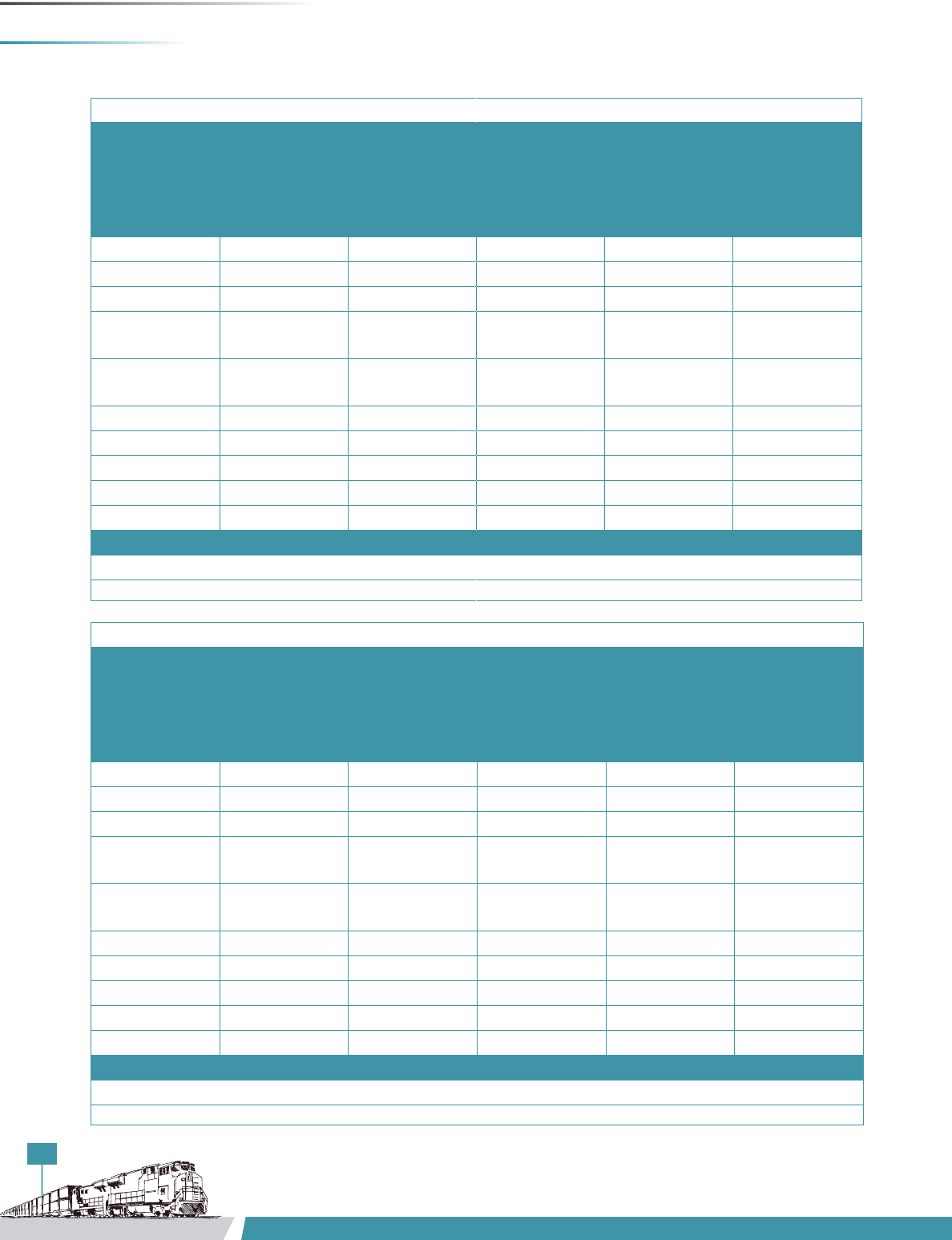
38
WORKING REPORT – FLY ASH
Table 15: Annual estimated costs for transporting fly ash from the Singrauli region to cement plants by road
S. no. Cement plant Location Distance by
road (km)
Estimated
annual fly-ash
demand
(in million
tonnes)
Estimated
annual
transport cost
by road
(Rs million)
1 ACC, Kymore Katni, MP 324 0.52 517.70
2 UltraTech, Dalla Sonebhadra, UP 109 0.12 46.92
3 UltraTech, Bela Rewa, MP 216 0.43 434.20
4 Jaypee, Chunar
GU*
Mirzapur, UP 186 0.49 487.20
5 Jaypee, Churk
GU*
Mirzapur, UP 123 0.01 4.68
6 Jaypee, Rewa Rewa, MP 213 0.60 603.20
7 Reliance, Maihar Satna, MP 285 1.02 1,015.00
8 Century, Maihar Satna, MP 285 0.45 451.25
9 Birla Corp, Satna Satna, MP 260 0.42 416.00
10 Prism, Mankahari Satna, MP 255 1.34 1,336.50
Total 5.39 5,312.65
*Grinding unit
Source: TERI analysis
Table 16: Annual estimated costs for transporting fly ash from the Singrauli region to cement plants by rail
S. no. Cement plant Location Distance by rail
(km)
Estimated
annual fly-ash
demand (in
million tonnes)
Estimated
annual
transport cost
by rail (Rs
million)
1 ACC, Kymore Katni, MP 308 0.52 244.02
2 UltraTech, Dalla Sonebhadra, UP 75 0.12 23.96
3 UltraTech, Bela Rewa, MP 480 0.43 302.88
4 Jaypee, Chunar
GU*
Mirzapur, UP 175 0.49 135.99
5 Jaypee, Churk
GU*
Mirzapur, UP 91 0.01 2.39
6 Jaypee, Rewa Rewa, MP 480 0.60 420.77
7 Reliance, Maihar Satna, MP 313 1.02 478.43
8 Century, Maihar Satna, MP 330 0.45 227.05
9 Birla Corp, Satna Satna, MP 415 0.42 249.60
10 Prism, Mankahari Satna, MP 437 1.34 845.20
Total 5.39 2,930.29
*Grinding unit
Source: TERI analysis
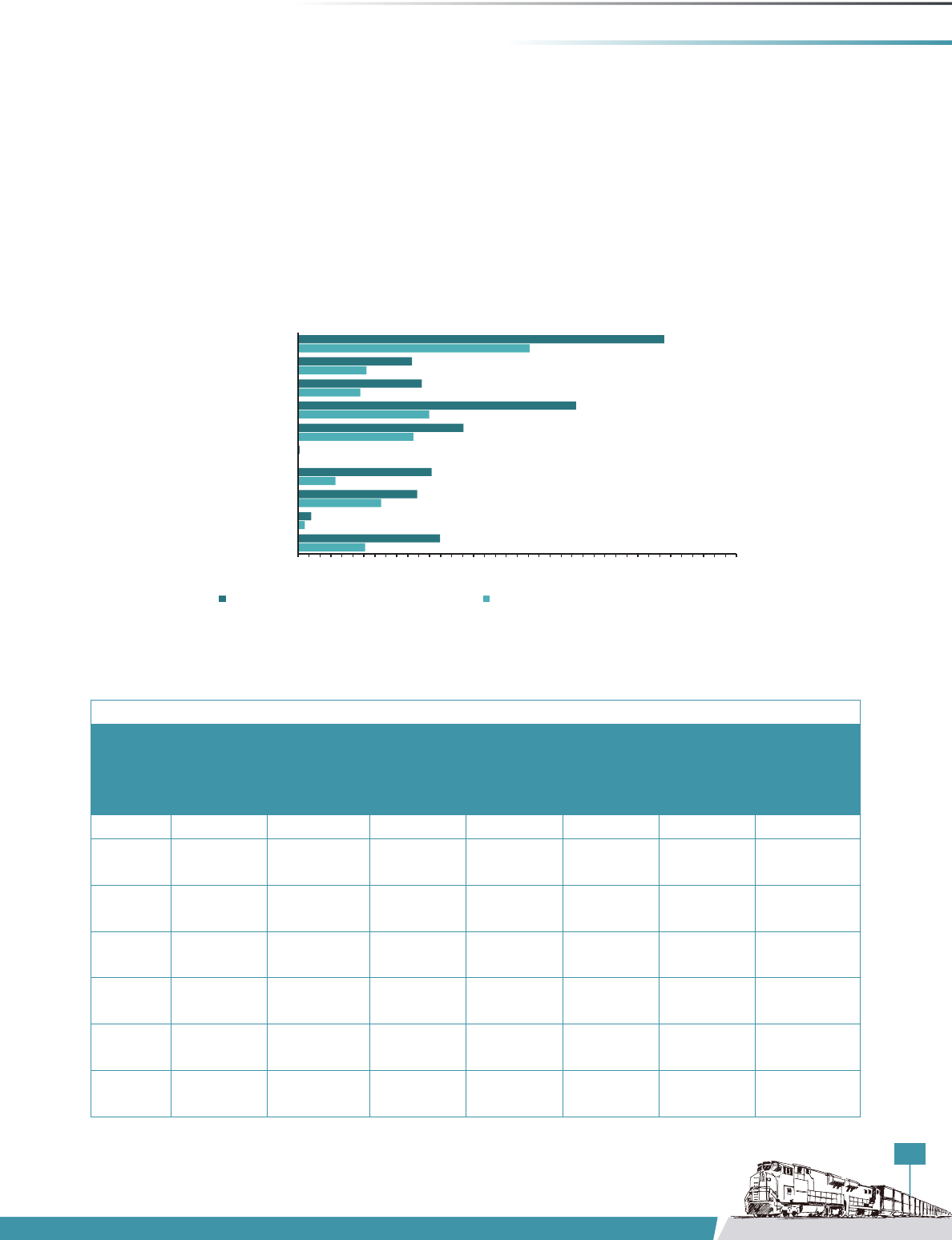
39
INCREASING RAIL SHARE IN FREIGHT TRANSPORT IN INDIA
Figure 27: Annual Rail and Road Cost Comparisons for Cement Plants
Source: TERI Analysis
244.02
23.96
302.88
135.99
2.39
420.77
478.43
227.05
249.60
845.20
517.70
46.92
434.20
487.20
4.68
603.20
1015.00
451.25
416.00
1336.50
0 200 400 600 800 1000 1200 1400 1600
ACC - Kymore
UltraTech - Dalla
UltraTech - Bela
Jaypee, Chunar GU
Jaypee, Churk GU
Jaypee, Rewa
Reliance - Maihar
Century - Maihar
Birla Corp - Satna
Prism - Mankahari
Annual Road and Rail Cost Comparison for Cement Plants
(in Million INR)
Annual Esmated Cost by Road (in million INR) Annual Esmated Cost by Rail (in Million INR)
Comparison of Transport Cost and Estimated Savings
The analysis presented in this section tries to estimate
the cost savings cement companies will make if
suitable infrastructure for loading and unloading of fly
ash for railway rakes is available at supplier and user
ends respectively. Considering the availability of such
infrastructure, the relative costs for transporting fly ash
by both rail and road modes have been estimated and
compared(seeFigure27).
ItisevidentfromFigure27thatroadfreightchargesare
much higher than the rail freight cost for moving fly ash
betweentheSingrauliandRewa–Satnaregions.Table17
shows the estimation of savings for cement companies,
if the mode of transport is shifted to rail.
Table 17: Comparison of road and rail costs as well as respective savings
S. no. Cement
plant
Location Distance by
road (km)
Distance by
rail (km)
Annual cost
by road (Rs
million)
Annual
estimated
rail cost (Rs
million)
Cost savings
if shifted
to rail (Rs
million)
1 ACC, Kymore Katni, MP 324 308 517.70 244.02 273.68
2 UltraTech,
Dalla
Sonebhadra,
UP
109 75 46.92 23.96 22.96
3 UltraTech,
Bela
Rewa, MP 216 480 434.20 302.88 131.32
4 Jaypee,
Chunar GU*
Mirzapur 186 175 487.20 135.99 351.21
5 Jaypee,
Churk GU*
Mirzapur 123 91 4.68 2.39 2.29
6 Jaypee,
Rewa
Rewa, MP 213 480 603.20 420.77 182.43
7 Reliance,
Maihar
Satna, MP 285 313 1,015.00 478.43 536.57
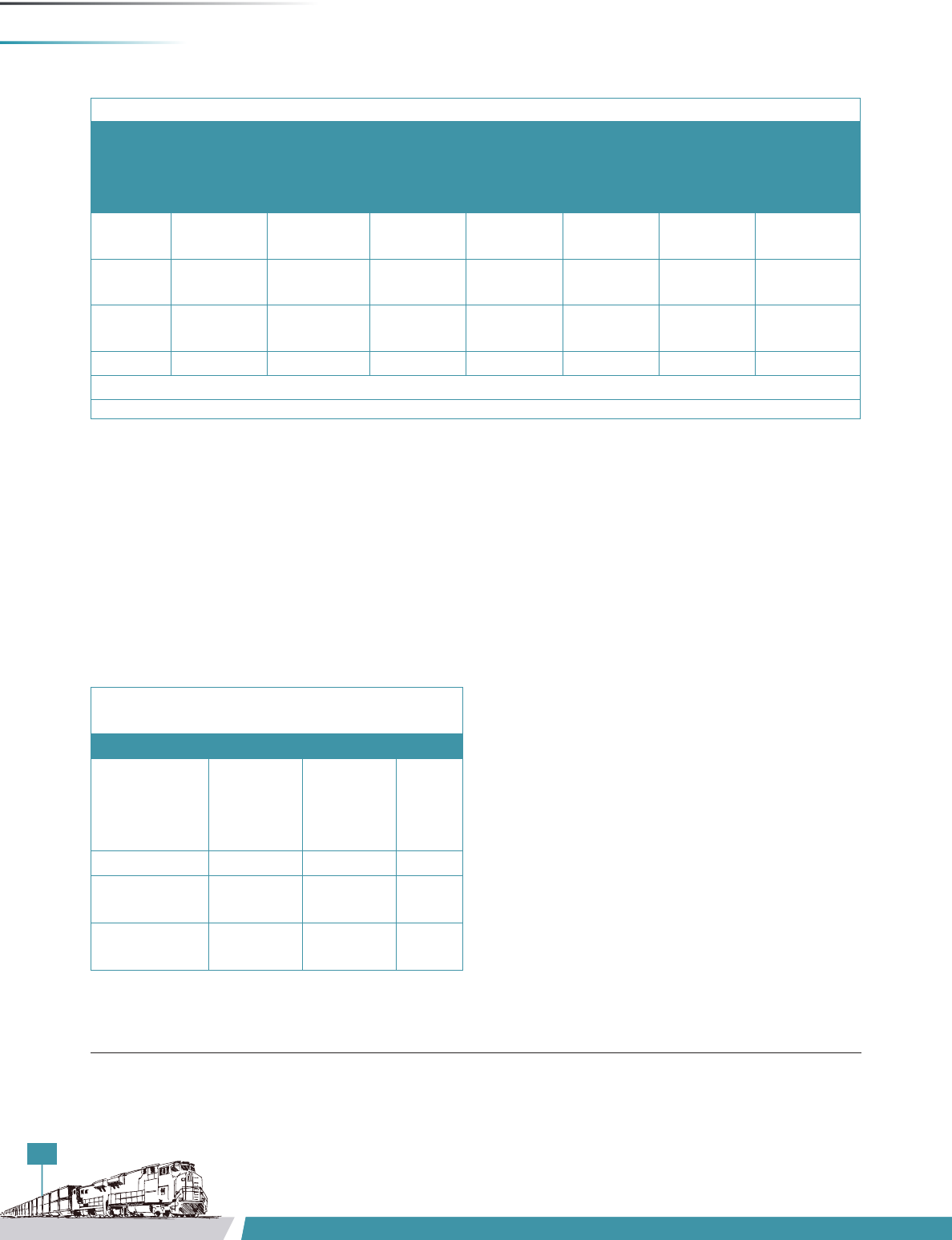
40
WORKING REPORT – FLY ASH
Table 17: Comparison of road and rail costs as well as respective savings
S. no. Cement
plant
Location Distance by
road (km)
Distance by
rail (km)
Annual cost
by road (Rs
million)
Annual
estimated
rail cost (Rs
million)
Cost savings
if shifted
to rail (Rs
million)
8 Century,
Maihar
Satna, MP 285 330 451.25 227.05 224.20
9 Birla Corp,
Satna
Satna, MP 260 415 416.00 249.60 166.40
10 Prism,
Mankahari
Satna, MP 255 437 1,336.50 845.20 491.30
Total 5,312.65 2,930.29 2,382.36
*Grinding unit
Source: TERI analysis
Estimation of Transport Emissions
For the same estimated distances between the two
regions, CO
2
emissions from both the modes have been
estimated. Table 18 shows assumptions made regarding
the same.
Based on the aforementioned assumptions, CO
2
emissions caused by transporting fly ash from the
Singrauli region to each of the selected cement plants
have been calculated for both rail and road. Figure 28
shows that fly-ash transportation by road causes a much
higher amount of CO
2
emissions when compared to rail
transport for the same distance.
Savings in CO
2
emissions, if the existing movement by
road shifts to rail, has also been estimated. Table 19 shows
the savings in CO
2
emissions for fly-ash transportation to
each of the selected cement plants.
In brief, the annual cost and CO
2
savings can be
summarized as the following:
¾ Shifting of traffic from road to rail will save the 10
cement companies an annual transportation cost of
INR 2382.36 million.
¾ Shiftingoftrafcfromroadtorailwillsave13795.83
tonnes of CO
2
emissions annually.
The fact that power plants and cement plants can be
observed in clusters can be considered an advantage
for transporting fly ash by rail, as this will encourage
the bulk movement of fly ash. Given the fact that the
demand for PPC is likely to increase in the coming years
and bulk transport by road has its own limitation, the
situation should favour fly-ash transportation by rail. But
Table 18: Assumptions made for calculating savings in
CO
2
emissions
For diesel trucks For rail
Mileage
10
3.59 km/ltr Rail
emissions in
kg CO
2
per
tonne km
11
0.00996
Diesel density
12
0.84 kg/ltr
Fly-ash carrying
capacity
13
30 tonnes
Kg CO
2
per
km
14
0.7375
10
Report on India Specific Road Transport Emission Factors (WRI, 2015)
11
See http://www.indianrailways.gov.in/railwayboard/uploads/directorate/traffic_comm/Rates-Letters/2017/6_%20Arun%20Kumar_MPPL_Carbon%20Footprint%20in%20Railway.pdf
12
Report on India Specific Road Transport Emission Factors (WRI,2015)
13
Primary survey
14
Report on India Specific Road Transport Emission Factors (WRI, 2015)
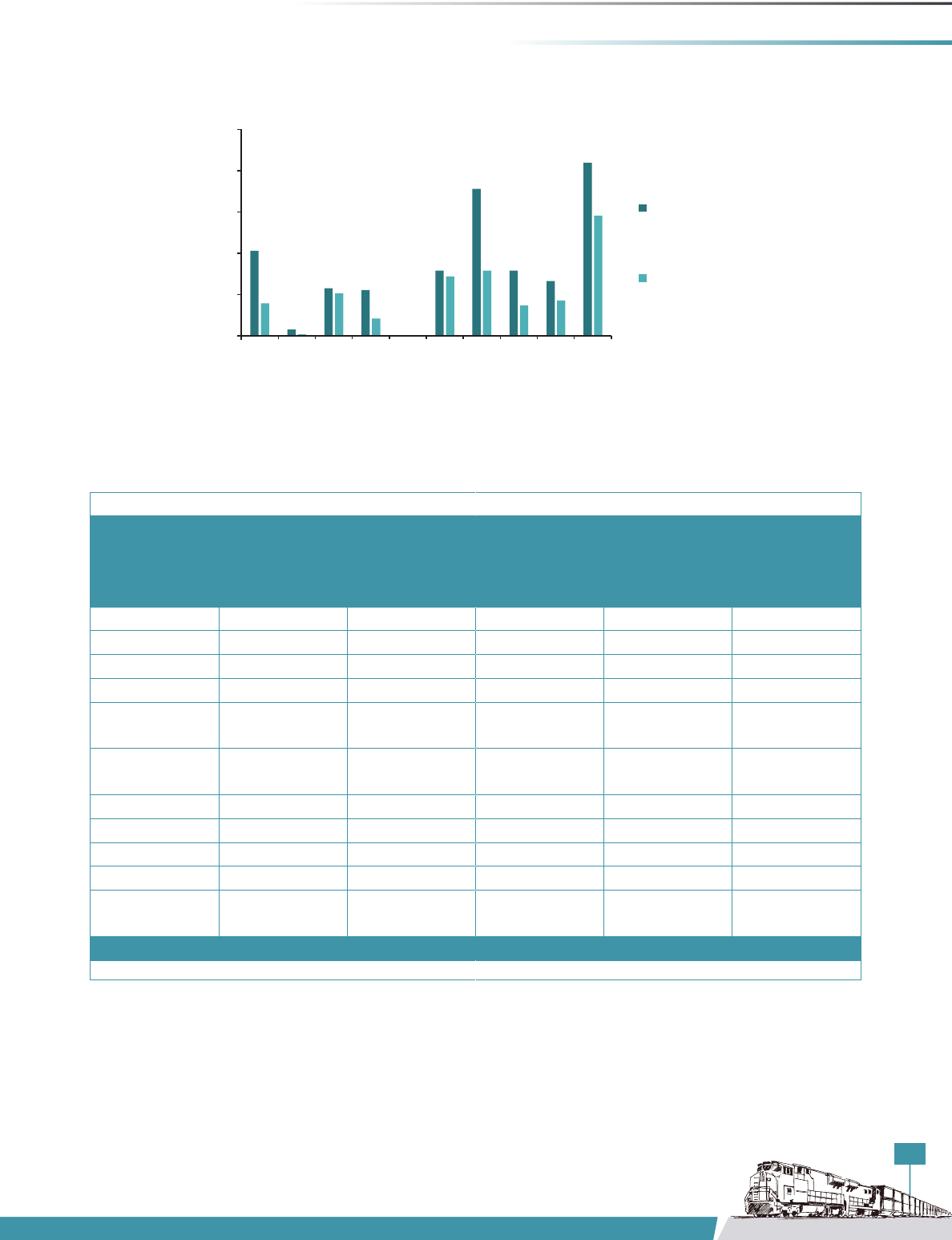
41
INCREASING RAIL SHARE IN FREIGHT TRANSPORT IN INDIA
4123
314
2306
2228
35
3159
7111
3162
2659
8378
1588
88
2076
849
11
2884
3164
1483
1719
5817
0
2000
4000
6000
8000
10000
Comparison of Annual CO₂ Emissions by Road and Rail
Total CO2 emissions
by Road (tonnes)
Total CO2 emissions
by Rail (tonnes)
ACC - Kymore
UltraTech - Dalla
UltraTech - Bela
Jaypee, Chunar GU
Jaypee, Churk GU
Jaypee, Rewa
Reliance - Maihar
Century - Maihar
Birla Corp - Satna
Prism - Mankahari
Figure 28: Comparison of Annual CO
2
Emissions
Source: TERI Analysis
Table 19 : Savings in CO
2
Emissions
S.No. Cement Plant Location Annual on Road
CO
2
emissions
(in tonnes)
Annual Rail CO
2
emissions (in
tonnes)
Annual CO
2
emissions saved
if shifted to Rail
(in tonnes)
(1) (2) (3)=(1-2)
1 ACC - Kymore Katni, MP 4,123 1,588 2,535.34
2 UltraTech - Dalla Sonebhadra, UP 314 88 226.69
3 UltraTech - Bela Rewa,MP 2,306 2,076 229.78
4 Jaypee, Chunar
GU*
Mirzapur, UP 2,228 849 1,378.53
5 Jaypee, Churk
GU*
Mirzapur, UP 35 11 24.77
6 Jaypee, Rewa Rewa, MP 3,159 2,884 274.73
7 Reliance - Maihar Satna, MP 7,111 3,164 3,947.10
8 Century - Maihar Satna, MP 3,162 1,483 1,678.40
9 Birla Corp - Satna Satna, MP 2,659 1,719 939.44
10 Prism -
Mankahari
Satna, MP 8,378 5,817 2,561.04
33,475 19,679 13,795.83
*Grinding Unit; Source: TERI Analysis
as with any other mode of transport, movement by rail
is also the function of a combination of factors, which
include modal suitability, ease of transport, and distance.
Therefore, to make a considerable modal shift from
roadways to railways, loading and unloading facilities for
rail,possibilityofmultiplerakeuse(forexample,yash
inonedirectionandcementinanother),andeconomic
feasibility of different routes for transporting fly ash
will also have to be looked into/studied by each of the
cement plants and TSPs considered under the analysis.

42
WORKING REPORT – FLY ASH
Issues
As per discussion with the various stakeholders from the
industry, the following issues have been identified which
are most probably responsible for the low modal share
of railways in fly-ash transport.
Issues with Indian Railways
a) Lack of Initiatives by Railways
At present, there seems to be a lack of substantial push
from the railways to encourage fly-ash transportation
in bulk. The Secunderabad division of the South Central
Railwaysmadeasuccessfulattemptbackin2007,when
a collaborative effort was made by NTPC, cement plants,
and Railways to transport fly ash in bulk between cement
plants and NTPC Ramagundam which benefitted all the
stakeholders. But apart from this, no such case studies
were found which focused on prioritizing fly ash as a
rail commodity or encouraged its movement by rail.
Therefore, in order to increase the fly-ash traffic by rail,
there’s need for such inter-agency collaborations where
all the parties can sit and discuss the hurdles involved in
moving fly ash by rail and arrive at a win-win situation.
b) Absence of Specialized Wagons
The wagons available to transport fly ash are not
environment-friendly. As per the CPCB notification,
specially designed railway wagons should be used for
transportationbyrail.Butasofnow,67%ofthey-ash
movement has been carried out in BCN wagons, which
are mainly used for transporting bagged cement. Being
an environmentally sensitive material, fly ash should
be transported in pneumatic hopper-type wagons.
But such wagons are only being used in a few regions
and are mostly privately owned. Although trials for
bulk transportation of fly ash in BTAP wagons has
been conducted successfully by NTPC in association
with Indian Railways and Texmaco (the wagon-
manufacturingcompany),(NTPCLimited,2017)approval
for its commercial run is still under process.
c) Non-Incentive Tariff Structure
At present, fly ash is being charged under class-120. Apart
from the base tariff, Railways charges a development
fee of 5% and busy-season charges of 15%. Demurrage
charges are also levied for the detention of wagons after
the expiry of free time. Also, fly ash has lower density
than cement. Since fly ash is being mostly transported in
the same wagons used to transport cement, the tonnage
of fly ash in full rake load, as compared to cement, is less.
The tonnage of fly ash in bulk cement wagon reduces
from65tonnes (cement) to 47 tonnes. (Nanduri, 2008)
And since Railways charges for the full rake load, the
customer has to pay the same freight for less quantity. All
these issues call for a revised tariff structure if Railways
has to compete with road transport in case of fly-ash
transportation.
d) Concession on Party-Owned Wagons
Railways provide freight subsidy if the wagon is owned by
the party itself under the ‘Liberalized Wagon Investment
Scheme’. The freight subsidy provided by IR in such cases
is 15% for a period of 20 years. The life of the wagon is
35 years. Cement manufacturers, however, want freight
subsidy for the complete serviceable life of the wagons
which are owned by the party.
Issues with NTPC
a) Lack of Rake Availability
Rake availability has been a major issue at times with
regard to fly-ash transportation. Since BCN wagons
are majorly used for transporting cement, priority is
given to keeping BCN wagons available for cement
transportation; hence, there’s shortage of these wagons,
especially for fly-ash transportation, for most part of the
year. Moreover, transporting fly ash in BCN wagons is not
an environment-friendly option, since fly-ash bags need
to be manually loaded into and unloaded from such
wagons, which causes dust emission. As discussed earlier
also, pneumatic hopper-type wagons are best suited in
such cases, as they minimize the chance of fly ash getting
airborne, but such wagons are not available as of now.
b) Commercial Reasons and Infrastructure
Issues
Specially designed infrastructure is needed to transport
fly ash in an environmentally sound manner at both

43
INCREASING RAIL SHARE IN FREIGHT TRANSPORT IN INDIA
the user and supplier end. Thermal power plants
should have loading infrastructure and cement plants
should have unloading infrastructure in order to put a
complete logistic chain in place. An investment of 80 to
90 crore is required to develop a loading and unloading
infrastructure. At present, it’s up to the power plants
and cement plants or end users to develop the loading/
unloading infrastructure, but cement companies are
hesitant to develop such infrastructure all by themselves,
as it needs a huge investment.
Issues with Cement Plants
¾ Although cement plants have developed
infrastructure facilities for loading and unloading
fly ash through trucks and bulkers, most of them do
not have the rake-handling facility to unload fly ash
at their end. Hence, there is a glaring lack of rake-
unloading facilities at most of the cement plants.
¾ As of now, the rate of fly ash sold by power plants
is mostly market-driven: lower where the demand
is less and higher where the demand is more.
There is a general understanding among cement
manufacturers that power plants should get into
a long-term agreement with cement plants to
ensure regular supply of fly ash, and there should be
some assurance regarding the tariff structure to be
followed over the agreed period.
¾ As discussed earlier also, various industry experts
agree that Railways should provide dedicated
wagons for transporting fly ash and bring down the
existing tariffs in order to incentivize cement plants
to shift to railways.
Recommendations
a) Inter-Agency Collaboration
There is a clear lack of inter-agency collaboration
when it comes to resolving issues related to fly-ash
transportation. Railways should take the lead in bringing
all the stakeholders, such as power plants and cement
plants, together so as to devise a strategic action
plan to increase fly-ash transportation by rail in an
environmentally safe manner, which shall be beneficial to
all the stakeholders, that is, TSP, cement plants, as well as
Railways. The case studies like that in the Ramagundam
region should be replicated at other places as well. The
fact that the thermal power plants and cement plants are
located in clusters should be considered as an advantage
for moving fly ash in bulk by rail.
b) Acquisition of Specialized Wagons
At present, the use of specially designed wagons such
as the BCFC and BCCW wagons, is only restricted to
transporting fly ash between cement plants in the Wadi
region and power stations at Ramagundam and Raichur.
These rakes are either owned by cement manufacturers
or are taken on lease from leasing companies. Presently,
Indian Railways has only two BCFC rakes available
for bulk transportation of y ash and cement (RDSO,
2013-14). BTAP wagons, which were earlier used to
carry alumina, are also now allowed to carry fly ash. The
Ministry of Railways, vide its circular dated 20 January
2017, has xed the permissible carrying capacity of y
ash in BTAP wagons to 60.36 tonnes
15
.
Using such high-capacity wagons will not only help in
transporting fly ash in an efficient and environment-
friendly manner, but will also help in reducing the loading
and unloading time at both ends. While the BCFC and
BCCW wagons are already in use, trials for BTAP wagons
are going on. NTPC has successfully conducted trials for
bulk transportation of fly ash in BTAP wagons from its
Rihand Power Station to the cement plants in the Satna
region. Therefore, planned investment should be made
on the design and acquisition of specialized wagons for
transporting fly ash.
c) Development of Terminal
Infrastructure
Lack of the required infrastructure facilities for loading
fly ash at power plants and unloading at cement plants
is another factor discouraging the movement of fly
ash by rail. Power plants should develop the facility for
loading fly ash from silos into rail wagons and cement
plants should install suitable unloading facilities such
as compressors and pneumatic pipelines to unload fly
15
See http://www.indianrailways.gov.in/railwayboard/uploads/directorate/traffic_comm/Freight_Rate_2016/Corri_RC_03_2016_200117.PDF

44
WORKING REPORT – FLY ASH
ash from rail wagons into ash-storage silos. Although in
case of BTAP rakes, fly ash can be directly unloaded into
bulkers through a mobile compressor system from BTAP
wagons at the railway siding itself. At present, only a few
power plants in the country have developed the loading
facilities for handling rakes, such as the NTPC plants
located at Ramagundam and Rihand, and Adani Power
Plant in Tirora. The creation of such infrastructure would
encourage the bulk movement of fly ash between TPS
and cement plants. On the one hand, cement plants will
benetfromsavingsintransportationcost(considering
thesignicantgapbetweenrailandroadtariffs),whereas
thermal power plants will benefit from the increased
utilization of fly ash, which will subsequently save them
a significant amount of capital spent on the creation and
maintenanceofashpondsforunutilizedyash.(Onan
average, thermal power plants spend Rs 96 per tonne to
store fly ash in ponds and 1,000 ltr of water per tonne is
wasted in doing so
16
)
d) Freight Subsidy
There’s a need to reduce or revise the tariff structure for
fly-ash transportation if Railways has to compete with
road transport. The reason is the low density of fly ash
because of which only 45 to 50 tonnes can be loaded
intoawagon,whichcanotherwise(ex-cement)loadup
to 60 tonnes. Also, demurrage charges should be revised
for fly-ash loading and unloading, as it generally takes
more than the stipulated hours to manually load and
unload a full rake of fly ash.
e) Rebate in Wagon Investment
Railways should consider giving a suitable rebate to the
investors interested in investing in their own wagons
for transporting fly ash. Under the ‘Liberalized Wagon
Investment Scheme’, Railways provide 15% concession
on freight for a period of 20 years. Since the lifespan of
a wagon is 35 years, increasing the concession period
to cover the entire lifespan of wagons would further
incentivize users to procure their own wagons and shift
towards railways, especially for fly-ash transportation.
Bibliography
CEA. (2016-17). Report on Fly Ash Generation and
Utilization in India. New Delhi: CEA.
CPCB. (2013). Guidelines for Loading, Unloading and
Nuisance free Transportation of all types of Fly Ash. Delhi:
Central Pollution Control Board.
MoCI.(2017).MinistryofCommerceandIndustry.
MoEF&CC. (2016). New Delhi: Ministry of Environment,
Forests and Climate Change.
Nanduri, S. (2008). Report on Utilisation of Fly Ash By
Cement Industry.
Narayan, R., & Mangla, M. (2016). Challenges of Ash
Management In Thermal Power Plants of Singruali
Region.
NTPC Limited. (2017). Bulk Transportation of y ash in
BTAP Wagons through Railway. New Delhi: NTPC.
Railways, I. (2017, January 20). Retrieved from http://
www.indianrailways.gov.in/railwayboard/uploads/
directorate/traffic_comm/Freight_Rate_2016/Corri_
RC_03_2016_200117.PDF
RDSO. (2013-14). Annual Report. New Delhi: Research
DesignandStandardsOrganisation(RDSO).
16
See https://timesofindia.indiatimes.com/city/nagpur/Not-using-fly-ash-fully-will-be-disastrous-for-environment/articleshow/55516458.cms

45
INCREASING RAIL SHARE IN FREIGHT TRANSPORT IN INDIA
THE ENERGY AND
R
ESOURCES
I
NSTITUTE
Creating Innovative Solutions for a Sustainable Future
